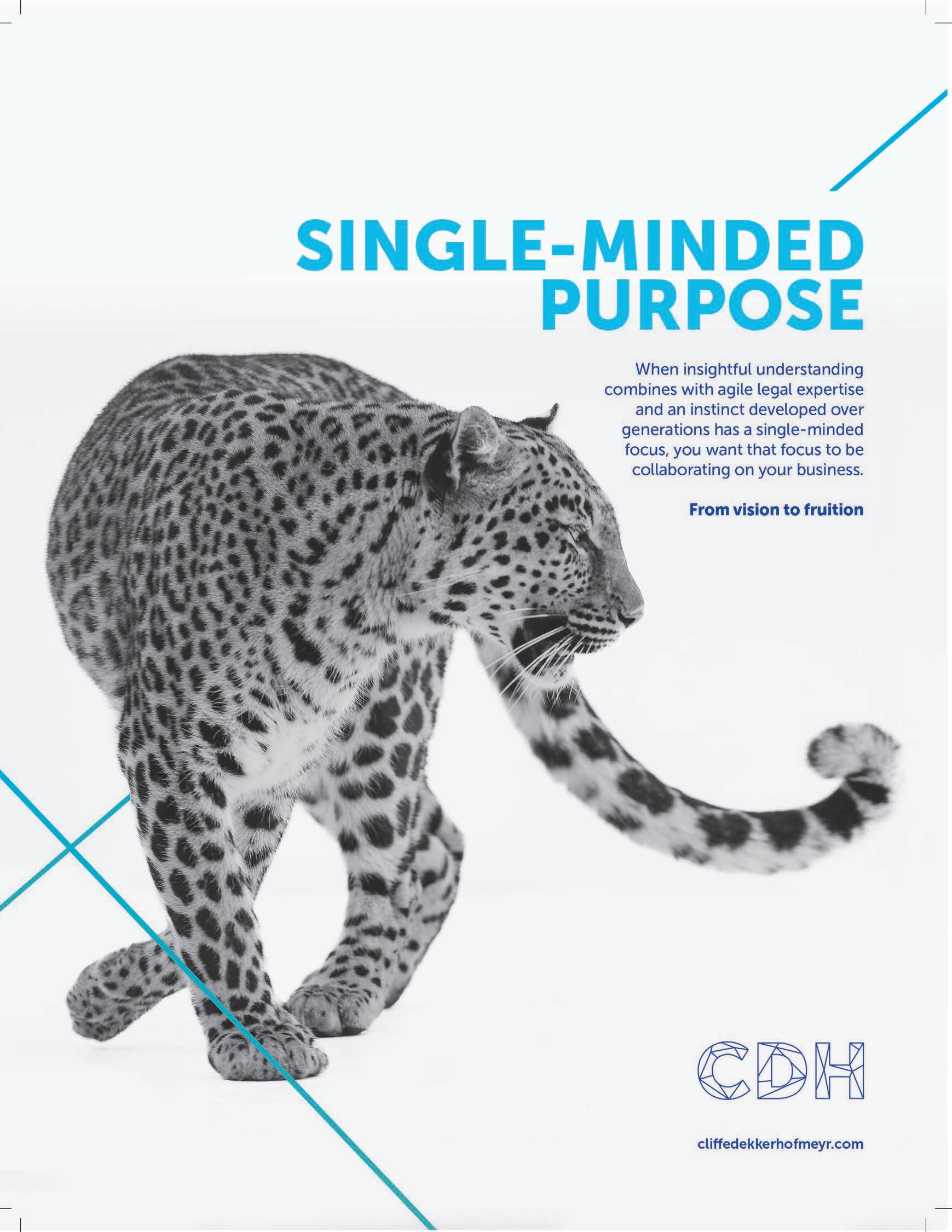

CONTENTS
4 CHARTING A NEW COURSE: THE CASE FOR A JUST ENERGY TRANSITION
The oil and gas industry has long been defined by convention and capital.
B y : Cliffe Dekker Hofmeyr.
5 THE FUTURE WE LEAD
Why women are central to sustainable business and the law.
B y : Fatima Gattoo, directorReal Estate Law.
7 CROSSING THE AISLE
Allies in the struggle for gender justice and beyond.
B y : Nadeem Mahomed, director – Employment Law.
9 DISRUPTION, DETERMINATION AND DISCOVERY
Not your typical law story, but one about finding your niche.
B y : Lebohang Mabidikane, director – Competition Law.
10 WOMEN BREAKING BARRIERS AND SHAPING LEADERSHIP
Women play a powerful and positive role in leading transformation.
B y : Lucinde Rhoodie, director –Dispute Resolution.
11 THE POWER OF THE PIVOT: LESSONS FROM AN UNCONVENTIONAL LEGAL PATH
Despite an on-off start to her career, mentorship has been the common thread in her career journey.
B y : Denise Durand, director — Dispute Resolution.
12 MILESTONES, STRUGGLES AND TURNING POINTS
Rising to become a leader through experiences and challenges.
B y : Yvonne Mkefa, director –Employment Law.
13 FROM XENNIAL TO ZENNIAL: TWO LAWYERS, ONE JOURNEY OF GROWTH AND GROUNDING
How generational differences shape experiences in the legal profession and what it means to grow while staying grounded.
B y : Nastascha Harduth, director –Dispute Resolution and head –Corporate Debt, Turnaround & Restructuring, and Tebello Mosoeu, senior associate.
15
THE ARCHITECTS OF SUSTAINABLE BUSINESS
Why women are central to sustainable business – connecting gender equity with business resilience and sustainability.
B y : Calinka Murray, Practice Development director.
16
WOMEN BREAKING GROUND
How women are carving a path in Namibia’s oil and gas sector.
B y : Ilda Dos Santos, director –Corporate & Commercial and Oil & Gas sector (Namibian Office).
17
ADVANCING GENDER PARITY IN INTERNATIONAL ARBITRATION
The legal profession has long been marked by under-representation of women, however, international arbitration presents a more optimistic picture.
B y : Veronica Connolly, senior associate – Dispute Resolution.
18
CHANGES, CHALLENGES AND COURAGE
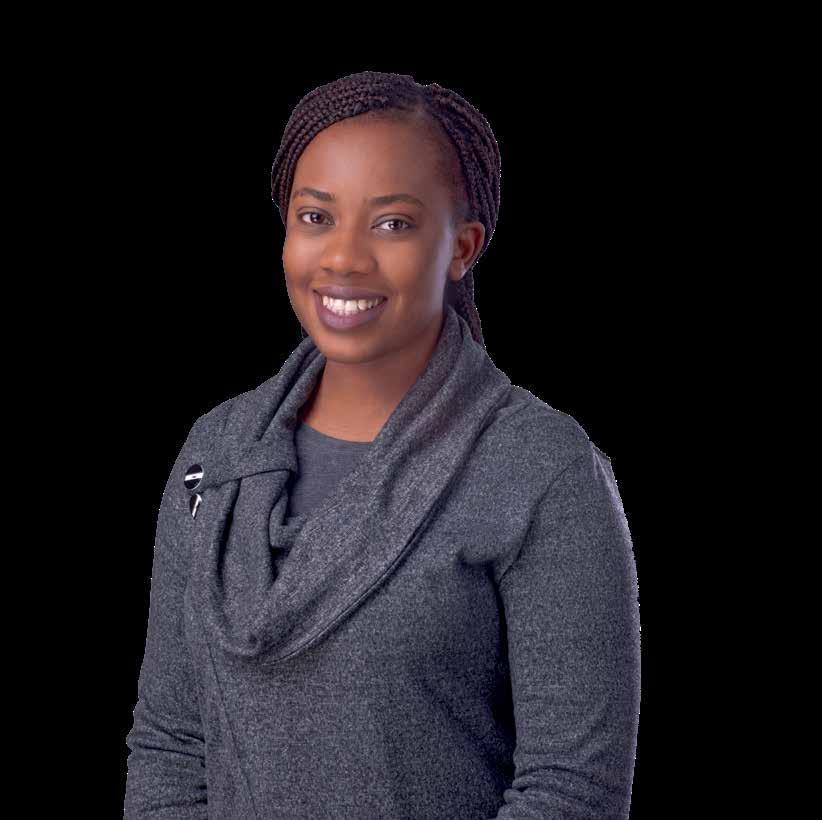
Recounting her experiences in a not-always-smooth sailing career journey.
B y : Belinda Scriba, director –Dispute Resolution. 19 26 25 25
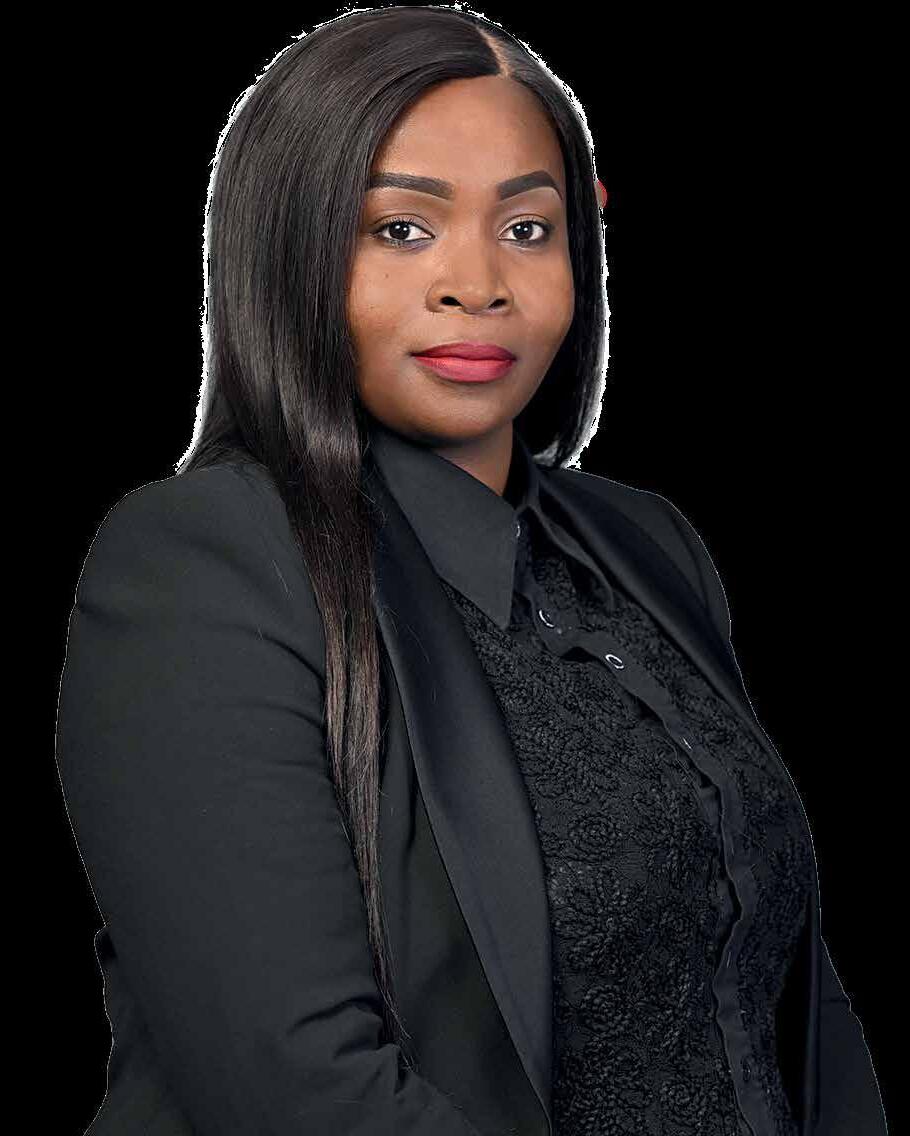
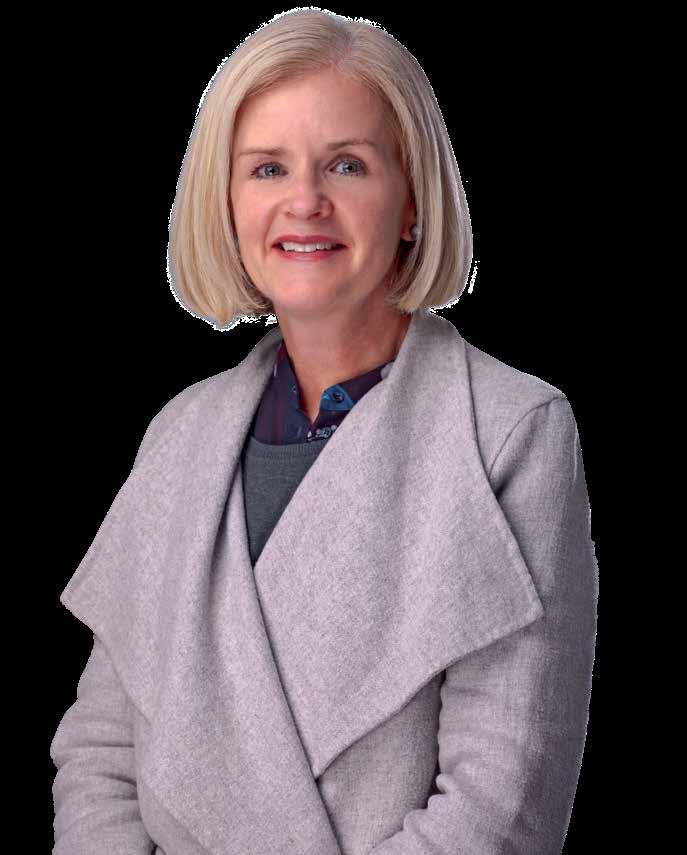

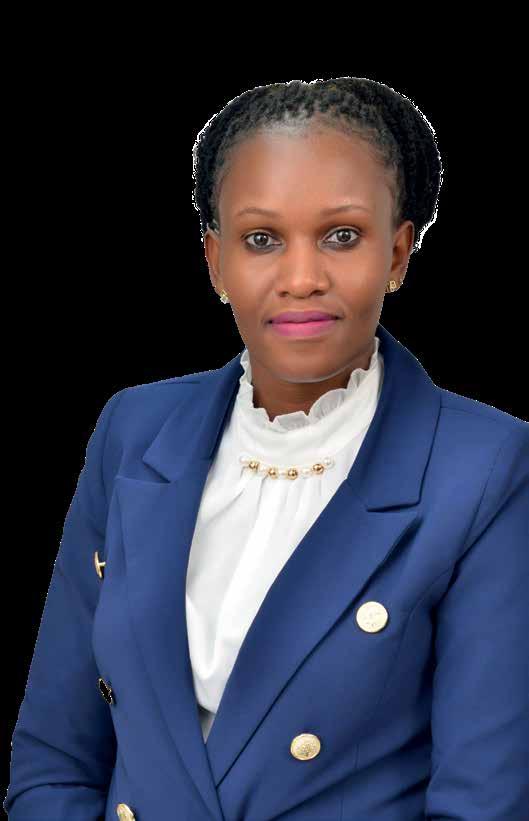

19 THE WEIGHT OF THE BLAZER
Reflections on her career, challenges, choices and responsibilities.
B y : Deborah Sese, senior associate – Corporate & Commercial (Kenyan Office).
20 PREPAREDNESS AND OPPORTUNITY
Reflections on a career filled with aspirations, possibilities, challenges and achievements.
B y : Sheilla Mokaya, associate –Corporate & Commercial (Kenyan Office).
21 LIFTING AS WE RISE
The importance of women mentoring women in law and business.
B y : Brigitta Mangale, director –Pro Bono and Human Rights.
22 WHEN OPPORTUNITY KNOCKS
Sometimes, the most rewarding careers begin not with a plan, but with an unexpected opportunity.
B y : Tessa Brewis, director –Banking, Finance & Projects and joint head – Projects & Energy.
23 MENTORSHIP AND COLLECTIVE UPLIFTMENT

Stories from mentorship relationships that have changed the trajectory of careers and lives.
B y : Kuda Chimedza, director –Banking, Finance & Projects.
24 THE PEARL THAT BROKE ITS SHELL
Embracing her youth, identity and circumstances to take her place at the table.
B y : Nomlayo Mabhena-Mlilo, director – Dispute Resolution.
25 SHOWING UP, AND DOING SO CONSISTENTLY
Secrets behind her success.
B y : Phetheni Nkuna, director –Executive Management Office and director – Employment Law.
26 THE FABLE OF THE FEE-BURNER
How the shared pursuit for excellence in the legal sector has shaped her career.
B y : Emma Hewitt, practice management director –Corporate & Commercial.
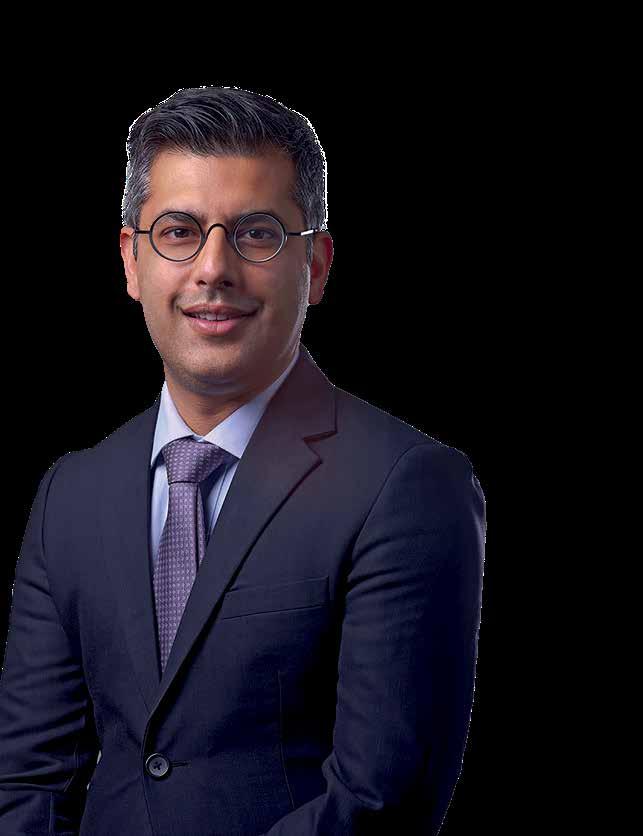

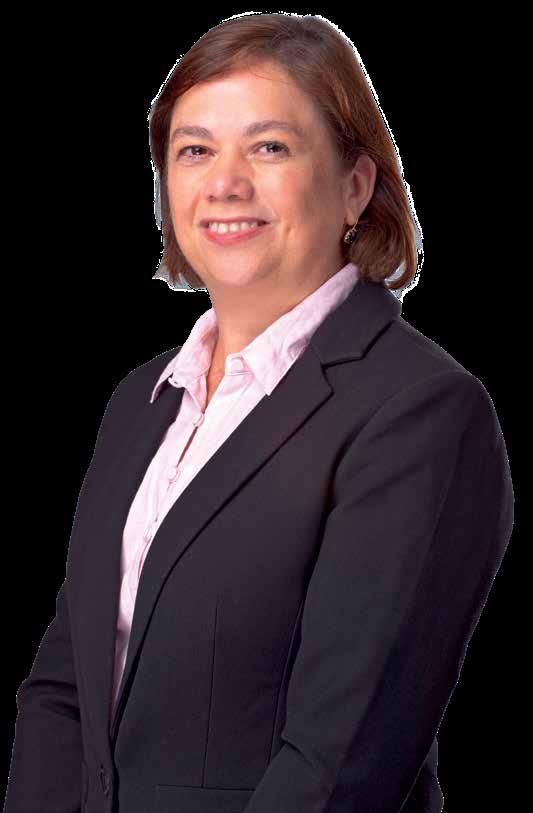
27 PURPOSE WITH POWER
Empowering change in
South African legal practice: the story of SA LawLabz, HiveLaw and the transformative role of female leadership.
B y : Retha Beekman, managing director of SA LawLabz.
29 LEGAL REFORMS EMPOWERING WOMEN
Two pivotal employment law developments advancing gender equality in the workplace.
B y : Anli Bezuidenhout, director – Employment Law, and Nadeem Mahomed, director – Employment Law.
31 BUILDING A BRAND WHILE BUILDING CONFIDENCE
Reflecting on her career journey, mentorship and leadership.
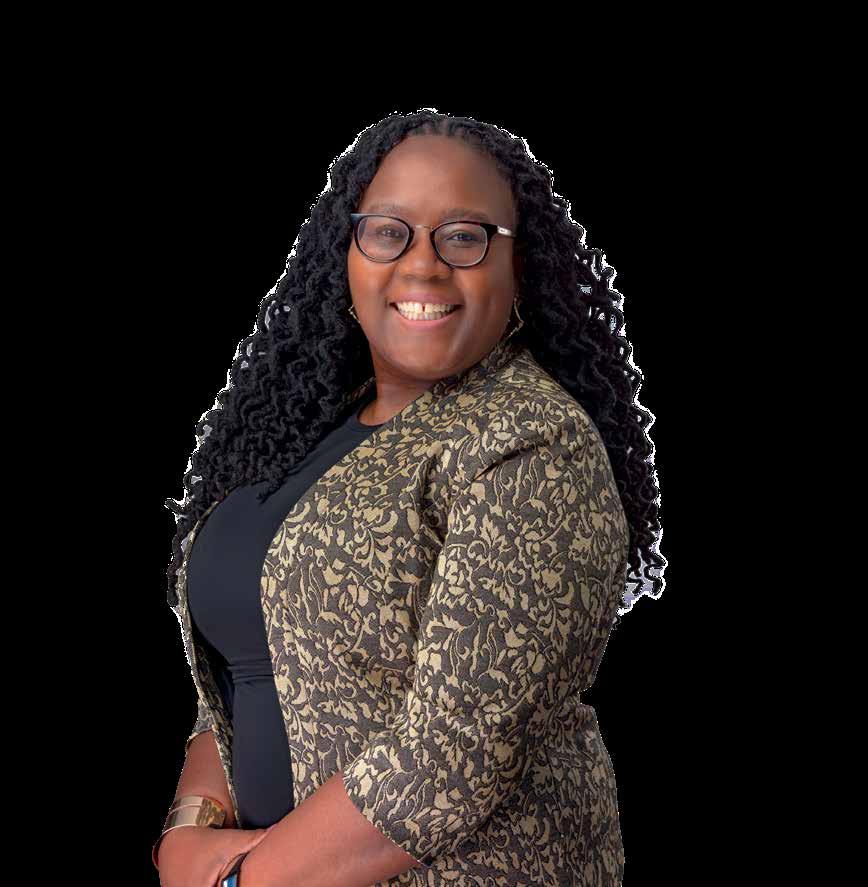
B y : Leila Moosa, senior associate – Employment Law.


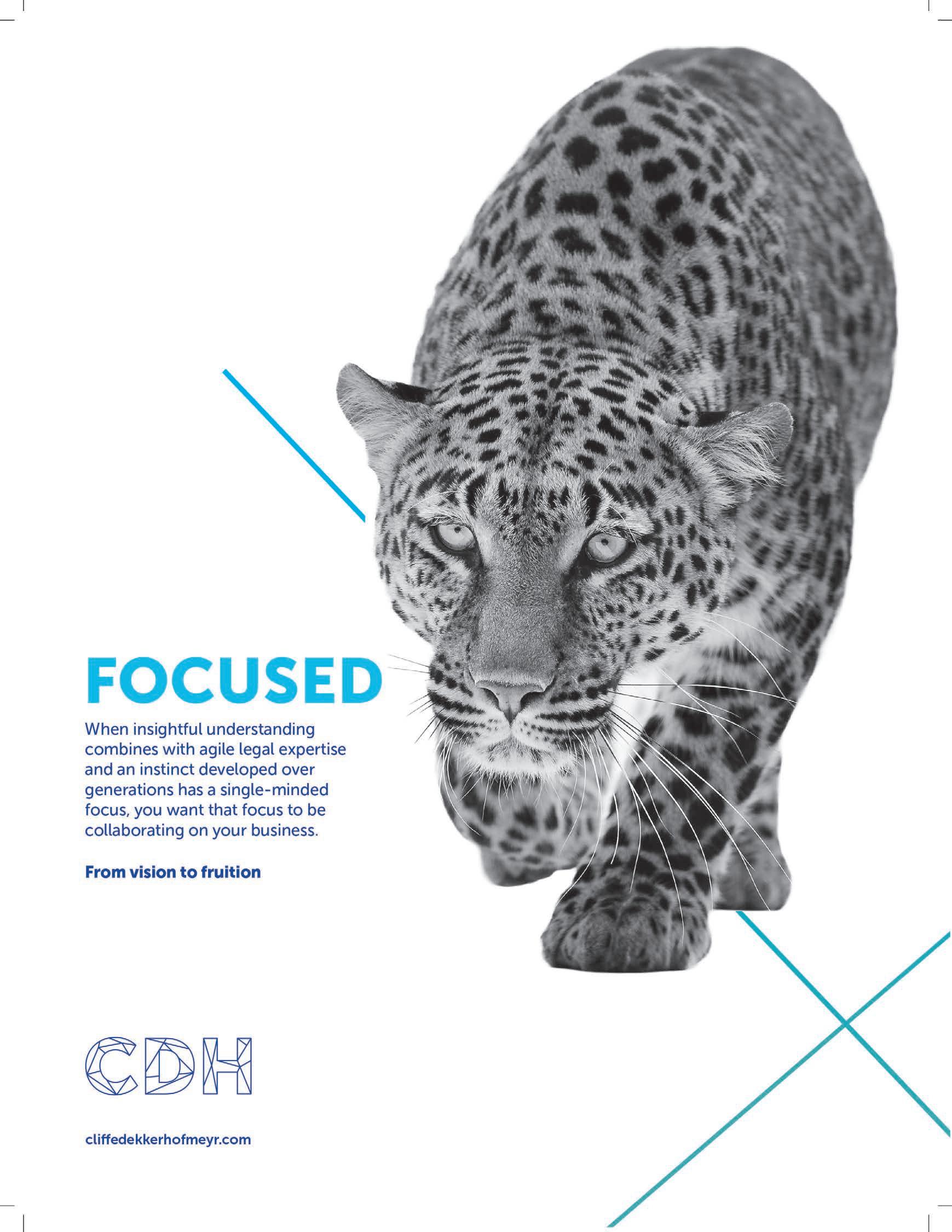
Charting a New Course: The Case for a Just Energy Transition
The oil and gas industry has long been defined by convention and capital. However, as we peer deeper into the mists of complexity, what this sector truly needs – and has always needed – is something bolder: a catalyst for transformation. Megan Rodgers, head of the Oil & Gas Sector at Cliffe Dekker Hofmeyr, embodies that bold, forward-thinking leadership – guiding the industry toward a more innovative and inclusive future.
By CLIFFE DEKKER HOFMEYR
According to the 2021–2025 Women’s Empowerment and Gender Equality Strategy for the Energy Sector, women make up just 20 per cent of South Africa’s oil and gas workforce, with a mere 17 per cent in middle or senior leadership roles. In a sector still shaped by deep-rooted barriers, where do aspiring women turn for a roadmap – or a role model? Enter Megan Rodgers who trained as an upstream mergers and acquisition (M&A) corporate and commercial lawyer. For the past decade, she has had a ful lling and fast-paced career in this unique area of law, viewing the energy sector in South Africa through an African lens.
“The energy sector sits at the heart of our nation’s growth story,” says Rodgers. “This is not just about volumes and capital. We need to focus on the transformation of our economy, our institutions and the opportunities we create for future generations.” Aligned with this, Rodgers brings legal precision, strategic foresight and a deep sense of responsibility to what she believes is one of South Africa’s most consequential industries. As a result, her name commands respect across boardrooms, government ministries and multinationals. However, it’s not just her expertise across the oil and gas value chain that sets her apart. It is her vision of an equitable energy economy that is commercially sound, socially inclusive and legally robust.
A TRUSTED ADVISOR, A PASSIONATE MENTOR
Rodgers is considered one of South Africa’s foremost experts on petroleum regulation and energy law. She is a trusted advisor on matters from upstream M&A transactions to the intricacies of the Upstream Petroleum Resources Development Bill in South Africa. Her work bridges the demands of global investors with the imperatives of national development. Yet, her leadership carries another weight: Rodgers is among the rst black women to occupy such a senior legal role in the male-dominated sector. And, she is determined not to be the last. “I’ve often walked into rooms where I was the only one who looked like me,” she re ects. “Now, part of my role is to make sure that changes.”
















frameworks that enable both investor con dence and broad-based participation.
Rodger’s leadership arrives at a pivotal moment. As South Africa accelerates the Just Energy Transition, the country needs legal minds who can translate ambition (and emotion) into action and do so with integrity. Rodgers is just that kind of leader. She does not just interpret the law; she helps shape the future it makes possible.
To the next generation of young women looking to get into oil and gas (or any industry for that matter), her advice is powerfully direct: “Be unapologetically excellent. Be clear on your purpose. Prepare thoroughly. Give yourself permission to learn every day, to make mistakes and to break down new barriers. Once you’ve claimed your space, use it to open the door for others.”
Rodgers isn’t simply advancing energy law. She’s forging a legacy – one deal, one policy and one up-and-coming leader at a time.













As part of this, Megan mentors young legal professionals with the same passion she brings to complex energy deals. She drives transformation not only through policy advice, but also through the culture she helps build within CDH, as a member of CDH’s executive committee, and across the profession. Rodgers also contributes thought leadership on the intersection of energy, justice and regulation, advocating for policy
















Megan Rodgers
THE FUTURE WE LEAD
Why women are central to sustainable business and the law
In the hive of leadership, true transformation begins with intention. When we speak of sustainability, the conversation often turns to technology, policy, and innovation. Yet one of the most powerful drivers of lasting change lies within our own organisations and communities: women. By
FATIMA GATTOO , director – Real Estate Law at Cliffe Dekker Hofmeyr
As we navigate an era de ned by climate urgency, social upheaval and economic recalibration, the case for centring women in sustainable business – and in the legal profession – is not just compelling. It’s critical.
NATURE’S BLUEPRINT:
THE HIVE AS A MODEL FOR LEADERSHIP
Consider the honeybee. When a hive loses its queen – the singular being capable of giving life to the colony – it faces collapse: no new eggs, no future.
However, the bees do not panic. They respond with clarity and collective wisdom. They choose transformation.
LEADERSHIP IS NOT INNATE – IT IS CULTIVATED. TRANSFORMATION OFTEN BEGINS NOT IN TRIUMPH, BUT IN CRISIS AND VISION.
Ordinary larvae are fed royal jelly – a rare, nutrient-rich substance. This act of nourishment changes everything. The chosen larvae are not born different, but they are treated differently. Their bodies grow stronger. Their life spans expand. Their destiny shifts.
A queen emerges – not by birthright, but by care, vision and support.
This is not just biology. It is a lesson: leadership is not innate – it is cultivated. Transformation often begins not in triumph, but in crisis and vision.
THE LAW FIRM AS A HIVE: A LIVING, BREATHING ORGANISM
In the legal profession, the metaphor holds. Law rms, like hives, are complex ecosystems. When faced with disruption – from climate regulations and environmental, social and governance (ESG) compliance to arti cial intelligence (AI) ethics and corporate accountability –they must respond not with fear, but with foresight.
And, in these moments, women lawyers rise – not by chance, but by crisis, vision and transformation.
The strongest leaders often emerge not from pedigree, but from potential. Not from privilege, but from preparation. Women in law, especially those who have been mentored, supported and fed opportunity, embody the qualities today’s clients and communities demand: resilience, empathy, clarity under pressure and a deep commitment to justice and sustainability.
WHY WOMEN MATTER TO SUSTAINABLE BUSINESS AND LEGAL PRACTICE
Sustainability is not just about carbon footprints or climate disclosures. It’s about longevity, responsibility and building systems that adapt and endure. In law rms and boardrooms alike, this means cultivating leadership cultures that re ect society – diverse, inclusive and driven by long-term purpose.
Women bring transformative value in at least four critical areas:
• Collaborative leadership: like the collective intelligence of the hive, women often lead with inclusion, empathy and consensus – fostering cohesion and trust.
• Client alignment on ESG goals: female legal and business leaders are at the forefront of integrating environmental, social and governance principles, not just advising on compliance, but shaping ethical direction.
• Resilience during crisis: research shows women excel in crisis leadership, navigating transitions, social change and economic upheaval with steadiness and clarity.
• Mentorship and legacy building: women who rise often uplift others, creating sustainable leadership pipelines that rely not on luck or legacy, but on support and shared vision.
A SILENT BUT PROFOUND LESSON
The bee shows us, without words, that in times of great crisis, despair is not a gamble, but a moment for clarity. A plan. The right choice.
In the hive, a queen is not born. She is supported. Fed. Guided. And so it is in life, law and leadership.
It is not what you start out with that matters most, but what you are given, how you are treated and the choices others make around you, especially in dif cult times. Sustainable business is not just about better products; it’s about better people, better values and better leaders. Sometimes, it is in the darkest moments that the strongest leaders emerge. Not by chance, but by crisis, vision and transformation.
THE PATH FORWARD: INTENTIONAL INCLUSION, SUSTAINABLE PRACTICE
To build businesses and law rms that thrive for generations, we must move from
tokenism to transformation. That means we must be serious about women. We must design ecosystems – like the hive – that nurture potential over pedigree, and cooperation over competition.
• Make equity intentional, not incidental. Choose equity not as a slogan, but as a strategy.
• Support, promote and invest in women at every level.
• Rede ne success – not as short-term pro t or billable hours, but as sustainable impact.
• Lead beyond the boardroom or courtroom into the community.
SUSTAINABLE
BUSINESS IS NOT JUST ABOUT BETTER PRODUCTS; IT’S ABOUT BETTER PEOPLE, BETTER VALUES AND BETTER LEADERS.
Just as bees respond to existential threat with remarkable instinct, so too must we meet this moment of global transformation by creating space for new leaders to rise. Often, those leaders will be women. Not by chance, but by choice. Not just for diversity, but for the future.
In the hive of business – the hive of the law – the future we lead depends on who we choose to support and how we choose to grow.
Women are not a “nice-to-have” in sustainability; they are central. They are the future we lead.


For more information: www.cliffedekkerhofmeyr.com
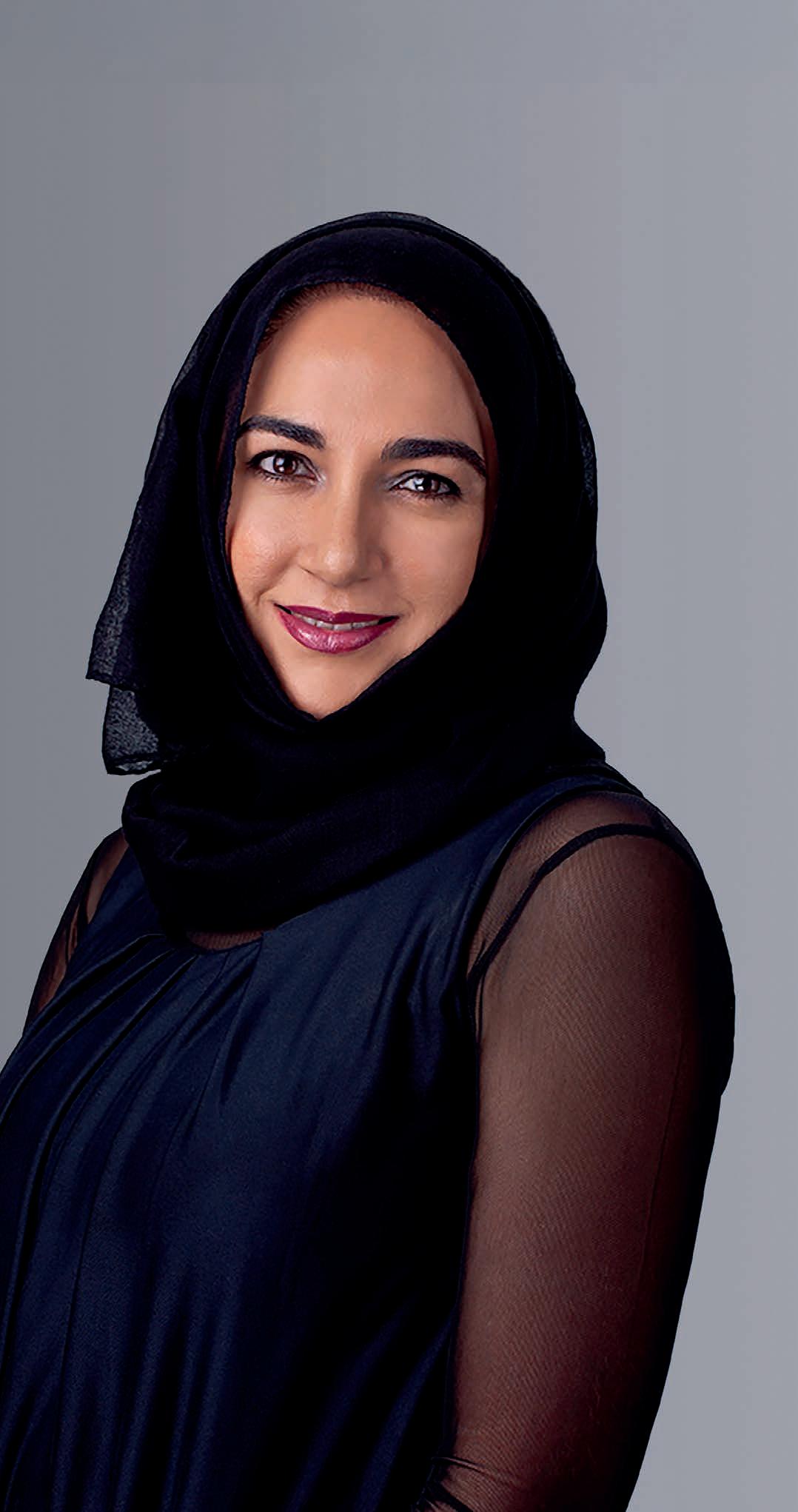
Fatima Gattoo
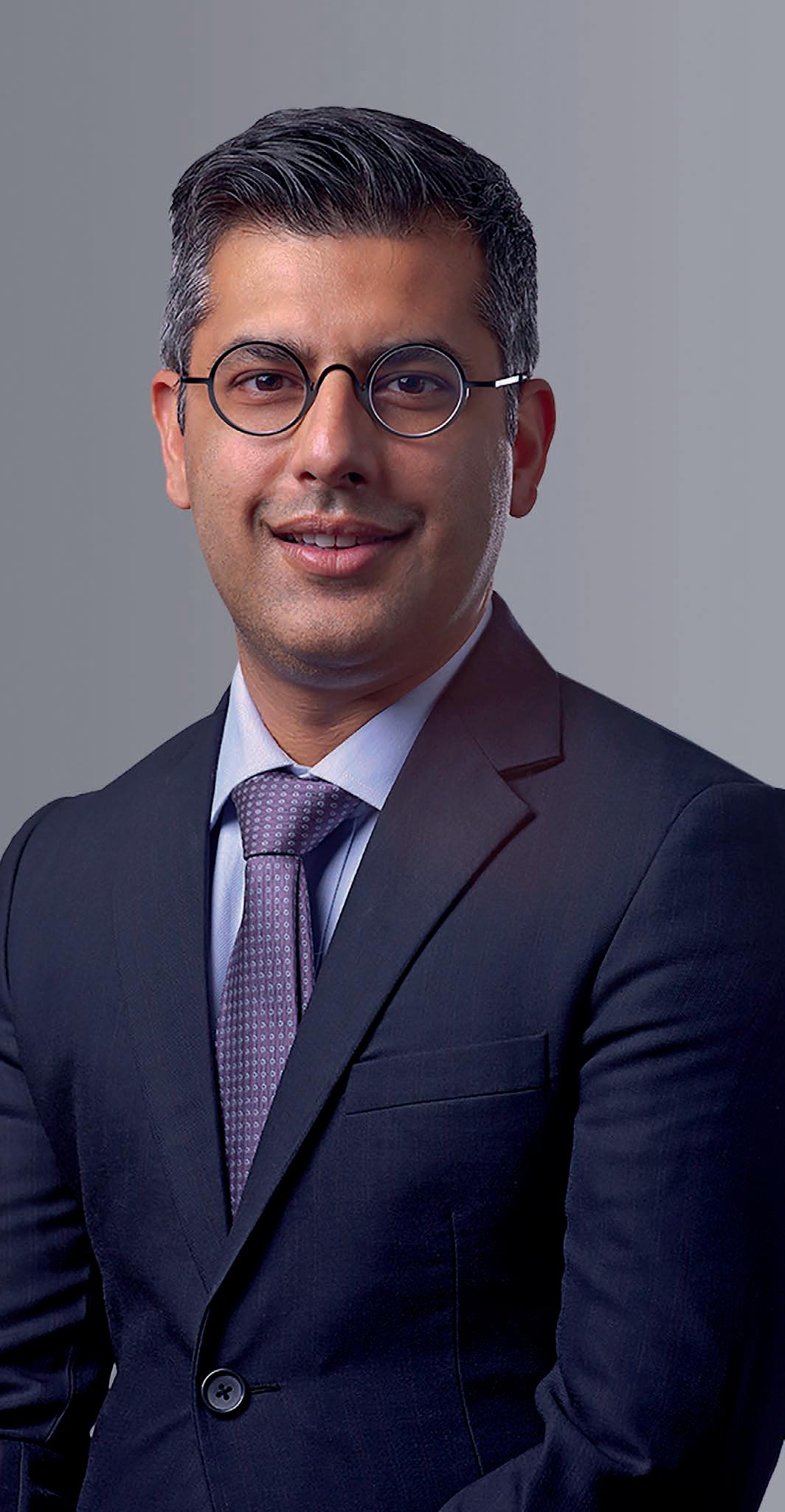
CROSSING THE AISLE Allies in the struggle for gender justice and beyond
Allyship, particularly from those in positions of privilege, is more than a gesture – it’s a moral responsibility. True allyship to all women demands humility, self-reflection, and a willingness to lean into discomfort, writes NADEEM MAHOMED , director – Employment Law at Cliffe Dekker Hofmeyr
As a lawyer, I was trained to view the law as a powerful mechanism to shape and structure society; an instrument to right wrongs, resolve uncertainty and impose order. In many contexts, this is partially true: the law can provide stability and predictability, particularly where the rule of law is rmly upheld. Yet even in such contexts, the stability law brings is often layered upon histories of exclusion and violence. More often than not, the legal system upholds the prevailing social order even when that order is unjust.
Even where laws are progressive, the assumption that they automatically yield justice is misguided. The transformation of moral aspirations into legal principles does not guarantee the realisation of justice in lived experience. The association between law and justice is persistent, but
Nadeem Mahomed
dangerously simplistic. Take apartheid South Africa as a stark example: legality and systemic injustice were often synonymous. Racial segregation, economic disenfranchisement and the violent subjugation of black people were legal norms, sanctioned by the judiciary and entrenched through statute. The same system upheld deeply patriarchal structures. In the Cape Colony, sanctions for sexual crimes against women were not applied equally. Race, especially that of the victim, determined how or whether justice was pursued. Women of colour were denied the dignity and protection afforded to white women, who themselves were not adequately protected from patriarchal violence within marriage. In these systems, the law did not correct inequality, it reinforced it.
MISOGYNY, PREJUDICE AND EXCLUSION
Fast-forward to contemporary South Africa where gender-based violence remains a crisis. While the Constitution and statutory framework offer protection for all human bodies, the reality is dissonant. The gap between legal ideals and lived realities is often vast. It is from this place, of both legal training and life experience, that I write: not necessarily as a lawyer, but as someone acutely aware of the many ways exclusion is perpetuated, legally and otherwise. Misogyny, like racism, is not always overt or intentional. It can manifest subtly: in assumptions, in cultural norms and in systems where power is measured by conformity to a dominant mould. In the corporate world, discrimination often masquerades as a lack of “ t.” However, “ t” is frequently code for assimilation into pre-existing, male- (or race-based) dominated norms (how one works, demonstrates ability, speaks, thinks or socialises). Women and people of colour, among others, are often required to dilute or surrender parts of themselves to be accepted. They are judged against unspoken criteria that exclude difference.
TRUE ALLYSHIP DEMANDS MORE THAN SYMBOLIC GESTURES; IT REQUIRES SUSTAINED, TANGIBLE, AND PURPOSEFUL ACTION.
REAL TRANSFORMATION REQUIRES ACKNOWLEDGING THAT SYSTEMIC VIOLENCE AND EXCLUSION ARE OFTEN EXECUTED TACITLY, THROUGH STRUCTURES, SYSTEMS OR TRADITIONS AND SILENCES.
Toni Morrison captures this painful yearning for acceptance in The Bluest Eye, where a young black girl believes that if her eyes were blue, if she could embody whiteness, then she would be beautiful, she would be worthy. This internalisation of inferiority is not only in ction. It is the legacy of societies structured around narrow and harmful ideals of worth, legitimacy and exclusion.
THE HALLMARKS OF GENUINE ALLYSHIP
In this context, allyship, particularly by those who occupy positions of privilege, which is always relative and shaped by circumstance, is not a mark of distinction, but a moral obligation. With respect to gender and gender identity, being an ally to women, including transgender women and transgender men, is not an act deserving of praise or celebration; it is a duty. It entails recognising human dignity and actively making room for others and being willing to relinquish power when justice so requires. True allyship demands more than symbolic gestures; it requires sustained, tangible, and purposeful action.
Genuine allyship is a process. It requires humility, re ection and the willingness to be uncomfortable. Declaring oneself “anti-sexist” or “anti-racist” is easy. However, real transformation requires acknowledging that systemic violence and exclusion are often executed tacitly, through structures, systems or traditions and silences. Often, those who perpetuate it do so unconsciously, as passive custodians of an unjust order.
To not be sexist (or racist, or homophobic, or xenophobic, or Islamophobic, or antisemitic) is not a xed state. It is a continuous ethical journey. It demands that we scrutinise our beliefs, our assumptions and the reasons behind our actions. It demands that we ask dif cult questions about the ideologies that shape our politics, economics, world views and everyday interactions. The ever so eloquent writer, James Baldwin once wrote, in respect of the American context:
“Whatever white people do not know about African Americans reveals, precisely and inexorably, what they do not know about themselves.” The same holds true for men in respect of women, or heterosexuals in respect of queer people, for example. Our prejudices, even when buried under years of moral labour, never fully disappear. They linger as the residues of the societies and communities that shaped us. They remind us of the persistent gaps in our ethical selves, gaps that require constant vigilance, care and correction.
MISOGYNY, LIKE RACISM, IS NOT ALWAYS OVERT OR INTENTIONAL. IT CAN MANIFEST SUBTLY.
Allyship, then, is not only about speaking on behalf of others, it is also about listening. It is about stepping back, stepping aside and sometimes stepping down. It is about confronting the hollow spaces within ourselves where prejudice and indifference thrive and refusing to let them de ne who we are, or what kind of society we build.


more information: www.cliffedekkerhofmeyr.com
DISRUPTION, DETERMINATION AND DISCOVERY
Let me start with the ultimate disclaimer: law is not for the fainthearted. It’s not glamorous. You will not suddenly become in uential, prestigious or purposeful the day after you graduate. It’s a calling that demands all of you, especially at the start of your career. And, if you’re a young woman, particularly a young black woman, that demand can feel endless. However, this is not a story of despair. This is my story of disruption, determination and discovery. One that, I hope, will inspire you to follow the legal path that works for you.
I didn’t follow the script. I became a mother straight after matric. While my peers lled lecture halls, I was working at a bank, raising a child. I stayed there for six years, steadily climbing, but always feeling like I was capable of more. Law wasn’t a passion at the time – it was a practicality because I needed to attain professional and nancial stability for my daughter’s sake.
STUDYING, SURVIVING AND SOUL-SEARCHING
At 24, I walked into my rst lecture hall. Most of my classmates were barely out of high school. I was soul-searching in tutorial rooms and packing lunchboxes in the morning. Balancing parenting with studying wasn’t a cute juggling act –it was a matter of survival. While my peers were buying their rst cars, I was catching taxis to class. I had to remind myself it wasn’t a race. I wasn’t competing. I was building something big.







A turning point came in my second year. I was accepted for a vacation programme at one of the top law rms in South Africa. That exposure was everything. It opened my eyes to what was possible. Thereafter, I went on to do vacation work at various top law rms every six months.











This is not your typical law story, which is precisely why you should read it, writes LEBOHANG MABIDIKANE , director – Competition Law Practice at Cliffe Dekker Hofmeyr
SAY HELLO TO “BIG LAW” –WHEN THEORY MEETS REALITY
Even after excelling at university, nothing prepared me for articles in a top-tier rm. Nothing! It was like being ung into the ocean with only the theory of how to swim to keep you alive. I was the oldest in my intake. I was married. When serving articles you’re not a top student; you’re an extra pair of hands. It requires great humility to accept that you’re at the bottom of the food chain, which can be challenging.
THIS PROFESSION IS INTENSE AND REQUIRES PLENTY OF SELF-SACRIFICE.











I wanted to quit. The culture, the long hours and the fast pace drained me. My self-esteem was shredded. I was working myself into the ground, and it still didn’t feel like enough. When I nally nished my articles, I left practice to think about my career path; I was convinced I was done with practice. Then, I joined the Competition Commission as a junior merger analyst. That was my redemption. I felt valued, I rebuilt my con dence. My career ourished, and I learned something crucial: I was good at this, and I wasn’t done.












STAYING AT THE TABLE, ON YOUR TERMS
We don’t talk enough about how many women leave law practice and never return. This profession is intense and requires plenty of self-sacri ce. Without mentors, a support system or a reason bigger than the next promotion, you will struggle.
Becoming a partner at Cliffe Dekker Hofmeyr and a member of the executive committee was a milestone for me. However, it wasn’t the pinnacle. The real achievement has been learning to trust myself and knowing that the buck stops with me when it comes to advising clients and being comfortable with that. Now, I mentor young lawyers, especially women. I ask them the one question no one asked me during articles: “Is this what you really want and are you willing to work hard to grow in the profession?” I’ve seen people change their lives because of that question. Law has many paths. You don’t have to choose the one everyone else is on.


WOMEN BREAKING BARRIERS AND SHAPING LEADERSHIP
When I entered the legal profession in 1998 at the age of 23, the landscape for women was markedly different. Over the years, it has been encouraging to witness the transformation within the industry. Although the journey has been challenging, today we see a growing presence of women in courtrooms, client consultations and, increasingly, the boardrooms of leading law rms.
I am a director at one of South Africa’s top-tier law rms, where I practice in its Dispute Resolution department and lead a team that includes a female senior associate and a female junior associate. Sometimes I look back and wonder – how did I manage to get here? A signi cant part of my success, in addition to hard work and dedication, is due to the commitment, sacri ces and strides women have made in the legal profession.
LUCINDE RHOODIE , director –Dispute Resolution at Cliffe Dekker Hofmeyr, writes that women play a powerful and positive role in leading transformation
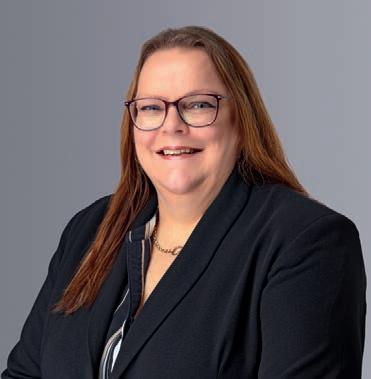
Our strength lies in embracing who we are – women in law – and leveraging that identity to lead with integrity and purpose. To pretend otherwise is misguided. The progress we see today is the result of generations of women who broke barriers and rede ned leadership in the legal eld. These advancements were not accidental nor were they easy; they were driven by individuals committed to change. The path forward demands continued advocacy, resilience and a collective commitment to equity.
We must continue to recognise, elevate and celebrate the invaluable contributions women make to leadership and social progress. Their collaborative and inclusive leadership styles, unwavering commitment to justice and equity and ability to drive transformational change are reshaping both communities and organisations.
Let us remain committed to creating spaces where women’s voices are heard, their leadership is celebrated and their impact is undeniable.
According to the 2024/2025 annual report published by the Law Society of South Africa (as it was then known), women now comprise approximately 45 per cent of the 33 929 registered attorneys. Furthermore, data from 2022 indicates that there has been a seven per cent increase in women holding CEO and managing director positions between 2019 and 2022.
While these gures re ect meaningful progress, signi cant work remains, particularly in traditionally male-dominated legal practice areas such as corporate and commercial, tax, banking and nance, and dispute resolution.
INTENTIONAL ACTION AND SOLIDARITY
Young female attorneys often seek guidance on how to advance in this profession. My advice is simple: success does not require abandoning one’s identity.
Despite the progress, women still face systemic, cultural and institutional challenges, including gender bias, under-representation in executive roles and unrealistic expectations around work-life balance. Addressing these issues requires intentional action by all women in the legal eld. Women in leadership, in particular, must actively mentor emerging professionals, contribute to the development of gender equity policies within organisations and, most importantly, celebrate and amplify the achievements of other women.
Throughout my career, I have observed a growing culture of solidarity among women in law. In earlier years, young female attorneys often encountered more resistance from senior women than from their male counterparts. It has been great to see that, fortunately, this dynamic has shifted and mutual support among women is increasingly becoming the norm.
As Michelle Obama so powerfully stated: “There is no limit to what we, as women, can accomplish.” Her words serve as a reminder of the boundless potential that emerges when women are empowered to lead.


Lucinde Rhoodie
The Power of the Pivot: Lessons from an Unconventional Legal Path
Despite an on-off start to her career, DENISE DURAND , director –Dispute Resolution at Cliffe Dekker Hofmeyr, reflects on her journey
Ihad the time of my life at university, so much so that in my penultimate year, I was unaware that many of my classmates had already secured articles at law rms or were actively pursuing them. By the time I realised I should be doing the same, it was too late. I accepted my fate and decided to take a gap year armed with a law degree.
Less than a few weeks into my gap year, my father gave me the boot, no daughter of his was going to sit at home with a degree. That push turned out to be pivotal. A university mentor referred me to an internship opportunity at a mining company. What began as a short-term role evolved into a two-year stint managing mineral rights at a mining exploration and investment rm. What seemed like a series of chance events would later de ne the sector where I would build my career. While working as a mineral rights manager, I attended law school part-time in the evenings and completed half of my board exams. Eventually, I knew I had to nish what I started. I resigned to take up articles at a small rm in Sandton, aware that not having articles would eventually become a stumbling block. It was a tough decision, one that meant taking an astronomical pay cut and moving in with a friend to reduce costs. However, it was an incredible experience. I learned fast, I had to. It was sink or swim. Within a year, I quali ed as an attorney, and six months later, I secured an associate role at CDH, where I have been ever since.
I never saw any of my roles as temporary or transitional. Whether onsite with geologists in Phalaborwa or handling matters at the Randburg Magistrate’s
Court, my mindset was always: “I’m here, let’s learn as much as possible.” I believe this openness allowed me to grow deeply and meaningfully.
Looking back, I now see how those early experiences laid a strong foundation. Today, as a director, it’s remarkable to see how mining-related matters make up half of my legal practice, an interest that began during that internship.
MENTORSHIP’S GUIDING HAND
The common thread throughout my career has been the power of community and mentorship. A university mentor encouraged me to apply for the internship; a friend told me about a vacancy at a small rm and an acquaintance of a friend handed my CV to the hiring director at CDH. The relationships we have built, no matter how slight the connection, can impact our lives in unexpected ways. While “mentorship” has become a buzzword, I’ve been fortunate to have managers who actively trained and guided me. This journey has not been easy and as I continue to grow professionally, the nature of mentorship has evolved. It’s no longer just about technical skills; it’s about navigating the complexities of work-life balance. This balance is a pendulum swinging between sacri ce, boundaries, rest and nancial independence. I haven’t mastered it, and that’s why mentorship remains essential. It helps guide and reset, and I am where I am today because of the support I received from others.
Some people have a clear vision of their career path from the start. For others, like me, clarity comes in hindsight. I often sit with recent graduates or interns who
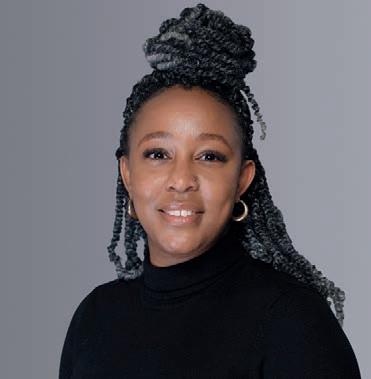
MENTORSHIP REMAINS ESSENTIAL. IT HELPS GUIDE AND RESET.
are grappling with grand ideas of how their careers should begin. Sometimes, these expectations cause them to overlook valuable opportunities because they don’t t a preconceived image of success. My advice: stay open and exible. The right doors often open when you least expect them and when they do, embrace them fully.


Denise Durand
MILESTONES, STRUGGLES AND TURNING POINTS
Leadership is a journey that involves others, and an individual rises to become a leader through their experiences and challenges, writes
The debate about whether leaders are born or made has persisted for ages. My view is that a person becomes a leader. Leadership is beyond innate abilities; it is about assuming the role of a leader and accepting the challenge to lead.
Having begun my journey at Bhekimfundo Primary School in Ekurhuleni, Gauteng, then studying law at Rhodes University, and now a director in one of the respected and leading law rms on the continent, I can attest that my journey has been one of becoming a leader.
Some individuals rise to leadership by repeatedly, consistently and diligently availing themselves of seemingly menial and mundane tasks. Over time, their consistent efforts are noticed, leading to greater responsibilities and involvement in signi cant projects.
YVONNE MKEFA
, director – Employment Law at Cliffe Dekker
of analysis paralysis. We have come to know this as the impostor syndrome. What happens when you become conscious of your leadership role? How do you respond when you realise that your actions and words shape how others show up and perform in their daily lives and that your decisions steer organisations?
I APPROACH EVERY TASK AND ASSIGNMENT AS AN OPPORTUNITY TO SERVE OTHERS.
RESPONSIBLE AND SERVANT LEADERSHIP
servant leader. I can trace this from my formative years and see it now in the way I approach important societal and life issues. One example is the longstanding ght to have “a seat at the table”. The ght is about diversity, equity and inclusion. However, it creates inner dissonance because it feels as if I must seek permission to serve others, and this does not resonate with me. There is no doubt in my mind, I became a leader. Although one could argue that I possessed leadership qualities all along, I cannot discount that the encouragement and belief of others enabled me to recognise and embrace my potential and gifts.









That has been the unassuming trajectory of my leadership journey. In my formative years, I led cultural events groups and cleaning projects. At university, I was involved in community outreach programmes. In the earlier years of my career as a young legal practitioner, particularly as in-house legal advisor, I was tasked with leading negotiations with employee organisations in SA and other parts of the world. In the latter years, when COVID-19 hit our shores, I was part of the crisis management committee for a listed company in nancial services, chairing some sub-committees.
You must be intentional about your leadership. You must be clear about your purpose, vision and direction. I became an ardent reader, reading about other leaders and their organisations. In 2022, I obtained a postgraduate diploma in leadership (cum laude) from Stellenbosch Business School (SBS). Through this course, I learned of my leadership style – servant leadership – and, more importantly, about responsible leadership



“The aim of responsible leadership is to create a better world for all and to ensure long-term sustainability,” states the SBS, Centre for Responsible Leadership Studies (Africa) website.



humbling. I never feel I have of I was part of the crisis nancial
Throughout this journey, maintaining balance has been crucial. It was essential to keep my home warm and ensure my family felt valued and an integral part of this journey. I am grateful to the Mkefa Clan for allowing me to “become”.
What’s next for me in my leadership journey? The title of Professor Bonang P Mohale’s book, Lift As You Rise, sums it up. As a leader, I must have a keen interest in the next generation of leaders. I must pay it forward.






























These were periods of unconscious leadership, lled with self-doubt and episodes

















Responsible leadership is not another leadership style, but a benevolent quality that must be engrafted in all forms and styles of leadership. I have embraced this call. This journey has been humbling. I never feel I have “arrived.” I approach every task and assignment as an opportunity to serve others. While I can lead using other styles, I am a hard-wired













Hofmeyr
Yvonne Mkefa
From Xennial to Zennial: Two Lawyers, One Journey of Growth and Grounding
Cliffe
Dekker Hofmeyr’s NASTASCHA HARDUTH , director – Dispute Resolution and head –Corporate Debt, Turnaround & Restructuring, and TEBELLO MOSOEU , senior associate in the same team, reflect on how their generational differences shape their experiences in the legal profession. One a Xennial, the other a Zennial, both navigating legacy, leadership and what it means to grow while staying grounded
















As women in law, the career journey is shaped not only by matters argued or contracts drafted, but rather by the moments that put you to the test, the mentors that lift you up, and the values that keep you grounded.
Q: Tebello, what drew you to the insolvency and restructuring profession?




Tebello: Early in my career, I worked with a director focused on insolvency. I noticed that we often came in too late –when companies were already distressed and disputes had escalated. That made me realise the value of earlier intervention, which helped me pivot more towards restructuring.
profession and continue to do so even now. As with many others, this profession really chose me rather than the other way around.
Q: Can you both share a memorable experience that shaped your approach?

Q: Nastascha, did the profession find you as well?





Nastascha: Absolutely. I started my articles in 2008 in an insolvency practice during the global nancial crisis. Work slowed down quite a bit during my commercial rotation in 2009 and when I was retained as an associate, I chose to return to insolvency practice. And then, business rescue was introduced just as the 2008 Companies Act took effect in 2011. You can say that I evolved with the


Nastascha: Early on, walking to court I was confronted by a vagrant who tried to grab and kiss me, which was really unsettling. However, it taught me a big lesson: con dence is key. I decided to walk with con dence and purpose after that, and it changed how I carry myself professionally (and, I haven’t been accosted by anyone since then). More recently, being involved in restructuring an airline and hearing from a stakeholder how I helped buy time and preserve jobs gave me real meaning and purpose in this work.
Tebello: I was involved in winding up a mutual bank and that, of course, required us to make recoveries in terms of the bank’s debt book. Given the various
“I HOPE WE MOVE TOWARDS PROACTIVE RESTRUCTURING WITH REGULAR FINANCIAL HEALTH CHECKS TO AVOID CRISES.”
– TEBELLO MOSOEU
Tebello Mosoeu
corporate entities that held accounts with the bank, it really showed me in a very short space of time the different forms of recoveries and their applicability to various scenarios.
Q: What trends do you see shaping the insolvency and restructuring field?
Tebello: Generative arti cial intelligence is a big one that is being incorporated into most industries, and I think its application to insolvency and restructuring could be quite exciting. It could help with data analytics and early distress detection, giving companies more runway to get themselves out of nancial trouble. I hope we move towards proactive restructuring with regular nancial health checks to avoid crises.
Nastascha: The future of this eld is also shaped by economic cycles. However, one must bear in mind that mismanagement of companies can happen in good times and bad. During economic downturns, there may be a greater volume of cases, but quality restructurings tend to be better during economic upturns due to more available capital.

“THE FUTURE OF THIS FIELD IS ALSO SHAPED BY ECONOMIC CYCLES. HOWEVER, ONE MUST BEAR IN MIND THAT MISMANAGEMENT OF COMPANIES CAN HAPPEN IN GOOD TIMES AND BAD.”
– NASTASCHA HARDUTH
Q: What advice do you have for aspiring insolvency and restructuring professionals?
Tebello: Stay informed by reading industry publications, attending conferences, and especially networking. Joining professional associations like SARIPA or the TMA can also be invaluable for growth.
Nastascha: Tebello is quite right –organisations like SARIPA and TMA don’t only give you access to formal education through accredited courses, but you can also learn a lot from their members who share their struggles and triumphs. Also, nd a mentor who will guide you and
sponsors who will promote you when you are not in the room. Lastly and probably most importantly, nd meaning in what you do.
THE EVOLVING FACE OF INSOLVENCY AND RESTRUCTURING LAW

Q: How do you see the future of the profession?

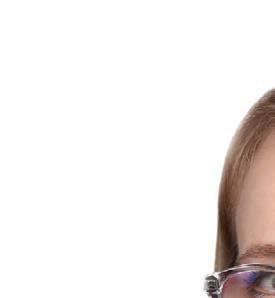

Together, Nastascha and Tebello embody the evolving face of insolvency and restructuring law – deep expertise with fresh perspectives. Their stories reveal that success in this demanding eld is about more than legal acumen; it’s about resilience, empathy, continuous learning and the courage to lead through change.




as regulations and economic
Tebello: I think we will see the greater use of technology, a stronger focus on sustainability, and far more cross-border collaboration. Professionals will need to be agile and adaptable as regulations and economic environments evolve.







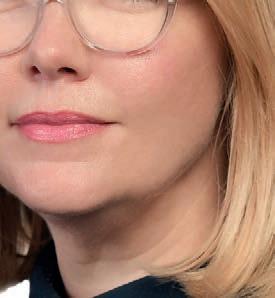





rescue. Unfortunately, I am also seeing far too many companies
Nastascha: While I agree with Tebello, I am also seeing a trend towards informal turnarounds (achieved by means of nancial and/ or operational restructuring) and away from formal processes like business rescue. Unfortunately, I am also seeing far too many companies going into liquidation that could have been saved through early intervention and a process like business rescue. Compromises in terms of section 155 of the Companies Act are underutilised, and I look forward to seeing if there will be an uptick in this area in the future.







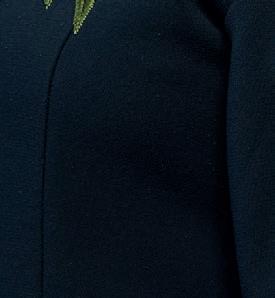


For


Nastascha Harduth
THE ARCHITECTS OF SUSTAINABLE BUSINESS
As businesses across the globe shift toward sustainability, one of the most impactful, yet often underacknowledged, drivers of this change is the leadership of women. We are shaping strategy, embedding environmental, social and governance (ESG) principles into operations, and fostering workplace cultures grounded in inclusion, ethics and resilience. Our work is not just helping companies meet sustainability goals, it’s rede ning what sustainable success means.
The role I play within my organisation, alongside many other female legal professionals, illustrates that women are not just contributors to sustainable business; we are the architects.
REIMAGINING LEGAL CAREERS
Why women are key to sustainable business: linking gender equity with resilience and longevity.
By CALINKA MURRAY , Practice Development director at Cliffe Dekker Hofmeyr
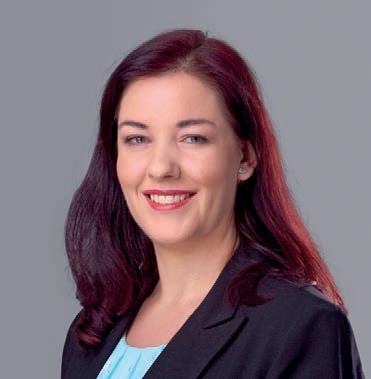
From a young age, I knew I wanted to pursue law. The ideal of doing what’s right and ensuring fairness deeply resonated with me. I started my career as a dispute resolution lawyer, but soon realised I was drawn toward building systems that support lawyers – especially junior ones –in more meaningful, lasting ways.
That realisation led me to a professional support lawyer role, and later, to complete a management development programme at the Gordon Institute of Business Science, equipping me with skills in operations, nance, innovation and strategy. Today, as a practice development director, I, among other things, lead transformation in one of my rm’s largest teams, helping shape the future of legal practice.
It hasn’t always been easy. Career paths are in uenced by many external factors. However, staying true to my values – prioritising growth and ful lment –has helped me chart a purposeful and sustainable career.
PEOPLE FIRST: MENTORSHIP AND INCLUSION
Sustainability is not just about climate and compliance; it’s also about people. A core part of my role is mentoring junior lawyers and building inclusive, supportive environments where these individuals can thrive. I’ve seen many women succeed in corporate legal practice, though few would say it was easy. The progress we’ve made is built on the efforts of those who came before us.
That’s why mentorship and advocacy remain essential. We all have a responsibility to be the change, supporting one another, opening doors and laying the foundation for future leaders.
ALIGNING LEGAL PRACTICE WITH ESG
Women across the legal profession in South Africa are leading ESG integration, structuring sustainable nance deals, driving climate risk disclosure and embedding ethics into business operations. My role focuses on aligning practice development with these goals: designing systems, processes and tools that re ect long-term thinking, social impact, commercial excellence and future-proo ng young individuals.
It’s not always smooth. Some innovations take time to prove their value. But in a rm like CDH, where agility is encouraged, I’ve learned that trial, error and persistence are part of driving meaningful change.
HIGH-PERFORMING, INCLUSIVE WORKPLACES
Inclusion fuels high performance. I strive to build a culture of openness, collaboration and knowledge sharing. Diverse teams where people feel safe to contribute consistently deliver better outcomes. Sustainability and inclusion aren’t separate goals; they reinforce each other.
Flexibility has also been key. As work models shift, I encourage people to de ne what balance looks like for them and communicate it clearly. This creates healthier engagement and more equitable, manageable work environments.
WOMEN AT THE CORE OF CHANGE
Women are not just supporting the sustainability movement; we’re leading it. Through mentorship, strategy, innovation and inclusive leadership, we are building businesses that are both principled and pro table.
The future of work and sustainability demands more than technical solutions. It requires people, especially women, who lead with courage, empathy and vision. For those of us who’ve taken a nontraditional legal path, the message is clear: we are not just adapting to the future of business – we are shaping it.


Calinka Murray
WOMEN BREAKING GROUND

ILDA DOS SANTOS , director
– Corporate & Commercial and Oil & Gas sector at Cliffe Dekker Hofmeyr’s Namibia
office, discusses how women are carving a path in the Namibian oil and gas sector
When I began my career at the Legal Assistance Centre in 2001, I was driven by a desire to make a meaningful contribution to society. Over two decades later, having worked across public interest law, Namibia’s state-owned energy sector and now private practice, I remain deeply committed to helping organisations navigate complex challenges in a way that is legally sound, commercially viable and, increasingly, socially responsible.
I’VE
SEEN HOW WOMEN BRING DISTINCT INSIGHTS TO CORPORATE STRATEGY, GOVERNANCE AND RISK, PARTICULARLY IN SECTORS LIKE OIL AND GAS, WHERE LONG-TERM THINKING IS CRITICAL.
These experiences have shaped how I now view inclusion and leadership. Gender equity is about more than female representation; it’s how we build institutions, support people and make space for under-represented voices in decision-making. In my career, I’ve seen how women bring distinct insights to corporate strategy, governance and risk, particularly in sectors like oil and gas, where long-term thinking is critical.
One of my proudest achievements was earning a master’s degree in oil and gas law from the University of Aberdeen in Scotland. This academic foundation supported my work in the Namibian and Angolan upstream oil and gas markets as well as downstream and midstream sectors, where I advised on acquisitions and disposal of acreage through farmout processes, supply, distribution, storage and handling transactions, and participated in contract negotiations.
SHARING KNOWLEDGE, BUILDING CAPACITY
While progress has been made in Namibia, with more women now occupying senior roles in the legal profession, systemic barriers remain. Gender bias still creeps into client or stakeholder meetings, where male colleagues are sometimes assumed to be the leads by default.
To shift the status quo, we need greater allyship from our male counterparts –both by deliberately creating space for women to lead and recognising the value of diverse perspectives in decisionmaking. Effective support means not only giving women a seat at the table, but also considering them for leadership roles on equal footing and acknowledging their skills and contributions.
Looking ahead, I’m focused on broadening my exposure to more international upstream, midstream and downstream transactions. The legal challenges in cross-border oil and gas deals are evolving, particularly with growing expectations around ESG (environmental, social and governance) compliance. Women lawyers have an important role to play here – not just as legal technicians, but as strategic partners who can bridge commercial imperatives with broader social goals.
To young women pursuing a career in law, I would offer this advice: be resilient, assertive, focused and committed. Never stop learning. Reach out to experienced professionals to grow your knowledge and build your capabilities. And, most importantly, know that your voice and contribution matter. Women are not just part of that future – we are helping to shape it.

As a woman in Namibia’s legal sector, my journey has required assertiveness, resilience and a continuous willingness to learn. When I joined the National Petroleum Corporation of Namibia (NAMCOR) as legal manager, I was one of the few women operating at a senior level in a male-dominated industry. Being heard, especially in technical negotiations and high-stakes meetings, often meant having to prove my credibility repeatedly. I quickly learned to stand my ground, prepare meticulously and lead with competence and composure.
What made these experiences especially rewarding was the opportunity to build capacity in others, particularly young women in the legal and energy sectors.























meant having to prove my meticulously























During my time at NAMCOR, I supervised several interns and employees and embedded knowledge transfer into our processes and corporate and commercial, particularly in the oil and gas sector. For me, true mentorship isn’t about handholding; it’s about setting high standards, offering support and trusting others to rise to the challenge.



















Ilda Dos Santos
Advancing gender parity in international arbitration
While the legal profession has long been marked by under-representation of women, particularly at senior levels, international arbitration presents a more optimistic picture, writes VERONICA CONNOLLY , senior associate – Dispute Resolution at Cliffe Dekker Hofmeyr
From Asia to America to Africa, women occupy some of the most senior leadership roles at international arbitral institutions:
•Singapore International Arbitration Centre: both the CEO and COO are women, and over half of the secretariat is female.
•Judicial Arbitration and Mediation Services (JAMS), US: led by a female CEO and president.
•International Chamber of Commerce: presided over by a woman, with women comprising more than half of the vice presidents.
•Stockholm Chamber of Commerce (SCC) and Arbitration Foundation of Southern Africa: both led by female secretary-generals.
These examples suggest that, at the institutional level, gender parity is not merely aspirational, but is increasingly the norm. In that respect, the gap might be considered “closed”, although caution should always be exercised to ensure equal representation remains.
ARBITRATOR APPOINTMENTS: A MIXED PICTURE
Representation of women on arbitral tribunals reveals a more uneven story. Institutional appointments re ect their leadership values, with a consistently high percentage of women being selected:
the story. The majority of appointments are made not by institutions, but by parties or co-arbitrators. In those instances, the proportion of women appointed is signi cantly lower:
•Female arbitrators were appointed by parties in LCIA arbitrations in just 22 per cent of cases in 2020, a proportion that had not improved by 2023 when it was just 21 per cent.
•The percentage of female arbitrators appointed by parties in SCC arbitrations has remained low and static over the last few years, uctuating between 27 and 31 per cent from 2022 to 2024.
•In 2024, only three per cent of appointments in proceedings before the Cairo Regional Centre for International Commercial Arbitration were women.
CLOSING THE GAP: ACCOUNTABILITY AND ACTION
To address the disparity between appointments made by institutions and those made by parties and co-arbitrators, it’s important to understand why the gap persists.
visibility in sectors where the profession has historically been male-dominated. Encouragingly, arbitration practitioners have launched signi cant initiatives to address this disparity. This year marks the 10-year anniversary of the Equal Representation in Arbitration Pledge being drawn up. With an aim to achieve fair representation of women on arbitral tribunals, it now has almost 6 000 organisational and individual signatories across six continents. Transparency initiatives, such as institutions publishing diversity data, are also driving accountability and accelerating change. There is much to celebrate in the strides international arbitration has made toward gender equality, particularly at the institutional level. However the persistent disparities in re ecting equality in arbitrator appointments demonstrate that real change depends on greater engagement on the issue by parties, their legal advisers and arbitral institutions. Maintaining progress requires ongoing attention to diversity, not just in gender, but also in race, age and background.









VISIT WEBSITE








•London Court of International Arbitration (LCIA): appointment of women by the LCIA court has remained high and stable, uctuating between 43 to 48 per cent from 2018 to 2023.
• London 48 per cent from 2018 to 2023.



• SCC: appointed women in ect reputation and informal the





•SCC: appointed women in 57 per cent of cases in 2024. However, appointments by institutions are only part of


One hypothesis is that appointments by and at institutions are subject to transparent processes with clear diversity policies and organisational accountability. By contrast, party appointment of arbitrators is governed by the discretion of parties (and their legal advisors), which can re ect unconscious bias or reliance on “safe” familiar names based on personal reputation and informal networks. This can lead to the overselection of male arbitrators who may have higher

information: www.cliffedekkerhofmeyr.com

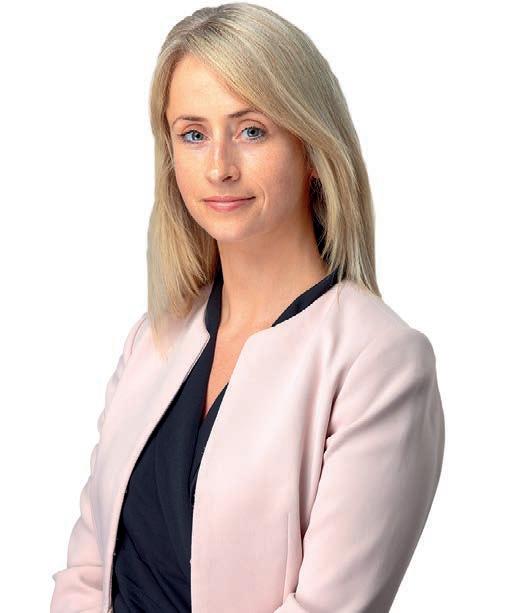

Veronica Connolly
CHANGES, CHALLENGES AND COURAGE
Cliffe Dekker Hofmeyr’s BELINDA SCRIBA , director – Dispute Resolution, recounts her experiences in a not-always smooth sailing career journey
When choosing the legal profession as your career choice – no matter your ethnicity, gender or culture – you knew (and know) it was (and is) going to be gruelling (academically and in practice). Coupled with that I was choosing to take the path in the 1990s. What that meant, given South Africa’s history, was that I was naively gearing myself up to tackle a white-male-dominated industry, hesitant to accept change of whatever nature. Add to that the big, no-nonsense “personalities” for which law was (and is) renowned, a tradition of teaching by breaking you down. If you were different from the traditional norm, it was always, by the very nature of the circumstances, going to be brutal. My saving graces were these – I have been blessed by my Maker to be a Gen Xer, I had wonderful mentors, I found an awesome partner in life, and (albeit slower than we would like) times were primed to change and start breaking norms, where differences are embraced and encouraged and bad behaviour is intolerable no matter your status.
Has it been a smooth journey? Of course not. However, the dif culties make you stronger and appreciate where your journey has landed you (even if you are still on it).
CHANGING OF THE GUARD
The reason being Gen X is relevant is because we are the generation that has been willing participants in important, groundbreaking transitions. We embrace arti cial intelligence assistance, yet we also remember receiving faxes (and sometimes miss “those days”). We were afraid to push back lest the dire consequences, but now encourage, support and learn from the subsequent generations who refuse to accept that old “norms”. The advantage
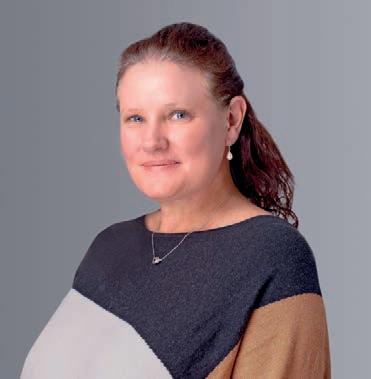
THE PROGRESS WE SEE TODAY IS THE RESULT OF GENERATIONS OF WOMEN WHO BROKE BARRIERS AND REDEFINED LEADERSHIP IN THE LEGAL FIELD.
of this? The old ways made us resilient and adaptable, the new ways allow us to be better mentors and teachers and, yes, lawyers. The “old guard” has either moved on or learned to change (perhaps reluctantly at rst, but for the most part, while it has been and continues to be a challenging expedition to change, it is happening).
Boy, have I been through the “wringer” (I challenge you to nd someone in this profession who has not). Articles, personality clashes, being told that having a baby was a death knell to my career, corporate politics, unreasonable clients and malicious opponents. All of which, at some point, make you question whether it is worth it or whether you are worthy of it. However, and I cannot emphasise this enough, most importantly, people who have your back, who teach you and guide you, who pick you up when you are down, who take you under their wing when you come back from
maternity leave, who ght your battles for you when you cannot, who let you cry with them when you have lost some battles (and believe me there have been some epic losses) are what gets you through when being resilient and adaptable is not enough. I have been blessed with these people (of both genders) throughout my entire journey.
In a nutshell, how I got from there to here? God, tenacity, an unwillingness to just “die”, a willingness to adapt a nd amazing mentors (professional and personal).
I can honestly say that the best part about being a woman when I rst started practising (and sometimes still today) is that your opponents underestimated you, taking your gender and timidness for weakness. Their mistake. The worst part is that your colleagues had the same attitude.
My goal for the future? To be as awesome a mentor as I have had in my journey, to continue ghting the good ght for clients, colleagues and juniors alike and to have the courage to continue pushing for change in one of the oldest professions.


Belinda Scriba
THE WEIGHT OF THE BLAZER
Using a blazer as a metaphor for responsibility, DEBORAH SESE , senior associate – Corporate & Commercial at Cliffe Dekker Hofmeyr’s Kenyan office, reflects on her career, challenges and choices
As a career woman, I have to choose the weight I carry every day, every minute and every second, but let’s go back a few years for context. I am an ordinary female, born and raised in Nakuru, Kenya. My mother, an ordinary woman from a not-so-well-off background who is a successful registered nurse, always impressed upon me that as a female, I must beat extra odds compared to male counterparts to achieve what I wanted in life. My mother has been a feminist for as long as I can recollect. When I asked her why university-entry grades in Kenya were lower for girls at the time, she explained that girls always start at a disadvantage – before they go to school, before they do their homework, they have to take care of some things, based on both nature and society’s gender role assignment. My father has been a great supporter of women empowerment and always afforded my brother, sister and me equal opportunities. He has also always supported his female siblings and contributed to their elevation in society.



While my parents’ efforts look like ordinary stories, they are worth telling to lightly demonstrate the role of parents in the choices their daughters make.

you believe is right, to take your place at the table and to not drop the ball when it comes to your family.
As a woman in legal practice, I have bene tted from good mentorship, which helped me beat many of the odds and enjoy my career as a family woman. My mentor, who was my supervisor from when I started my career, was very supportive, and when I communicated my intention to change employers, opened the door and wished me the best.
However, I have had to contend with the guilt of ambition, the consequences of the change in routine on my young family and the guilt of what could have been had I stayed on a bit longer, but I have recently understood the true meaning of change and hard choices. Surprisingly, male colleagues at my career level who have made such choices have not suffered from this guilt at any point. This realisation (and acceptance) informs my message to the ambitious girl/woman reading this –go for what you want, and it is okay to



THE CHOICES YOU MAKE EVERY DAY AFFECT HOW
HEAVY YOUR BLAZER IS AND HOW LONG YOU CAN KEEP WEARING IT.
battle with the doubt of consequences even as you make tough (but wise and informed) decisions.

CHOICES AND CHALLENGES




As a child, I worked extra hard in school, understanding that I had no room for failure. I set high goals for myself and believed I could achieve anything I put my mind to. Fast-forward to joining the legal career, in a eld of practice that can be quite competitive and consuming. Now in my sixth year of practice as a mergers and acquisitions and private equity lawyer, the blazer gets heavier by the day. The blazer is the choice to show up every day, to choose ambition over loyalty, to stand up for what















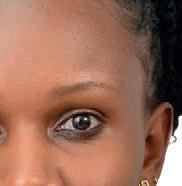
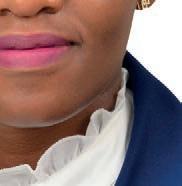





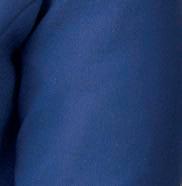












Your nature as a human being is a nurturer; this means you will battle with the longing to nurture society, work relationships and loyalty. You, however, need to be conscious of your goals and what you have to do, and go for it with grace and good coping mechanisms to wear a blazer that weighs differently every day. In short, nurture yourself rst. Most importantly, you can reduce this weight by choosing wisely –a good employer, good friends, a good partner and a positive attitude. The choices you make every day affect how heavy your blazer is and how long you can keep wearing it.













Deborah Sese

PREPAREDNESS AND OPPORTUNITY
Reflections on a career filled with aspirations, possibilities, challenges
and achievements.
By SHEILLA MOKAYA , associate – Corporate & Commercial at Cliffe Dekker Hofmeyr’s
Kenyan office
This being my birthday month, I re ect on aspirations, achievements, disappointments, and uncertainties, all of which are important for a balanced world view. Successes encourage us for the possibilities of the future and disappointments remind us that we are human and should be gracious to ourselves and others.
DO
NOT WAIT TO TICK ALL THE BOXES BEFORE SEIZING AN OPPORTUNITY AS THAT
I gured that the combination of a law degree, banking knowledge and my accounting quali cation would be a good t for transaction advisory. As such, I began the journey that has led me to my current position at Cliffe Dekker Hofmeyr.




As the rst-born child of my mother, a tailor, and my father, a welder, life has been a rollercoaster with many episodes in my childhood that have shaped my viewpoints. My “nomadic” experience, due to economic circumstances, saw me living in several towns in Kenya. It was very challenging to live away from home, and I quickly realised that if I wanted to have a better life, I needed to put in a lot of effort. Knowing what I know today, I wonder how I survived, but such are the Lord’s works – inexplicable. Would they be miracles if they could be explained? This upbringing instilled in me a sense of discipline and mental fortitude that has guided me so far. My parents’ love, belief and tenacity to ensure we received a quality education even in dif cult circumstances is something I will forever be grateful for.
WILL LIMIT YOU. THE SUREST WAY TO FAIL IS NOT TO TRY.
BE OPEN TO OPPORTUNITY AND BE PREPARED










So, what are the lessons here? Firstly, give yourself a chance. Do not wait to tick all the boxes before seizing an opportunity as that will limit you. The surest way to fail is not to try. Open yourself up to the chance and learn while at it. Always ask for help and seize opportunities to showcase your abilities, rather than waiting for them to be presented to you. Secondly, pursue excellence. Strive to be and give your best in all that you do. Aim for the gold standard. Choose to be honest, to be dependable and to do things right. Always aim for the best. Thirdly, be strategic and prepare for the opportunities. While waiting for the next big thing, improve yourself, acquire new skills and learn a new art. Opportunity should meet preparedness.



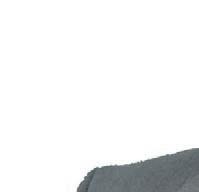
and set pathways for one to accomplish more after secondary school. This was particularly critical for me as no one in my paternal home had gone beyond secondary school, and everyone had almost accepted that secondary education was the ceiling for us all. Fast-forward and I excelled in the national high school exams and was admitted to a law degree programme with government sponsorship. After admission to the bar, I worked as a legal counsel for a local bank and later obtained an accounting quali cation.
national examination for primary education and secured a place at one of the top



magical key,
While at Rusinga Island, I sat the nal national examination for primary education and secured a place at one of the top national schools in the country, Alliance Girls High School, which would test my resilience and later open up limitless possibilities. Like the proverbial Zelda’s magical key, this would be my key to unlocking many doors. It was a realisation that education can transform lives















Zelda’s
Sheilla Mokaya
LIFTING AS WE RISE
Cliffe
Women constitute roughly 47 per cent of South Africa’s overall labour force. Yet, despite their overall presence, women remain signi cantly under-represented in senior management and leadership positions. Surveys conducted in 2024 revealed that women made up just 36 per cent of board seats in JSE Top 40 companies and only 23 per cent of executive management positions. While women are undoubtedly ambitious and aspire to career growth, they continue to face barriers to entry in advancing to higher-level positions. These barriers are varied in nature, but across industry and discipline, a common thread that cuts across these spaces is the absence of dedicated mentorship spaces for women on the rise, leaving a gap in women’s ability to aspire and inspire.
The value women in leadership positions add to business is undeniable. Female leaders are on average more trusted than their male counterparts, create spaces for collaboration and show empathy and compassion in engaging with their juniors and peers. Women in C-suite positions can offer unique and diverse perspectives, positively in uencing a business’s culture and environment, leading to increased productivity and pro t.
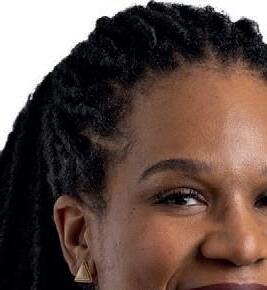
So, if this is what the data is showing, why do women still face these barriers to to entry, and
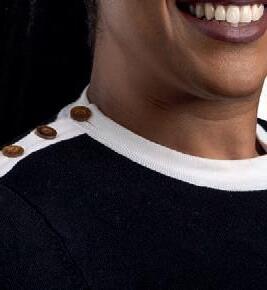

Dekker Hofmeyr’s BRIGITTA MANGALE , director – Pro Bono and Human Rights, discusses the importance of women mentoring women in law and business
why don’t we see more examples of women lifting as they rise, creating spaces for female juniors to thrive and excel, decreasing the need for these female juniors to have to reinvent the proverbial transformation wheel?
AN ONGOING FIGHT FOR EQUALITY
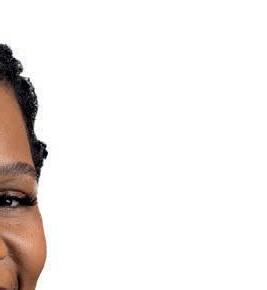


In my experience, the issue isn’t as straightforward as one would think. For as long as we can all remember, women have had to ght tooth and nail for a seat at the table, and then have had to continue to ght to be heard once seated at the table. In advancing my career, I have found that, on average, it was my male seniors who freely created mentorship spaces and dedicated themselves to my growth, while my female seniors seemed preoccupied. It was only as I began to grow in seniority that I began to understand this preoccupation: role, often, doesn’t equate to respect.
Most reputable businesses have internal transformation targets that require a certain number of women to ll positions at various levels within the company. However, unfortunately, most businesses simply leave it at that and
don’t take the further steps necessary to ensure their company moves towards true empowerment and transformation, not merely tick-box gestures. Structures are not put in place to allow women the choice to advance in their careers and simultaneously nurture their families, to deal with workplace harassment that doesn’t magically disappear when women rise through the ranks or break down the barrier to entry to the ever-elusive boys’ club. Instead, when women rise to power in title, they still have to ght to earn the respect of their male counterparts and for their voices to be heard.
The ght is not over when women are promoted; they must simply turn their attention to a different ght, leaving little room for attention to mentorship and empowerment. Businesses can better support women’s ability to create mentorship spaces by ensuring women in leadership positions are properly and meaningfully supported in their roles, allowing them to not only turn their attention to mentoring juniors, but also giving them the space to ourish and positively contribute to pro tability and culture. Women mentoring women is critical to a business’s success, but it can only be achieved through collective action and collaboration.


Brigitta Mangale
WHEN OPPORTUNITY KNOCKS
TESSA BREWIS, director – Banking, Finance & Projects and joint head – Projects & Energy at Cliffe Dekker Hofmeyr, writes that sometimes, the most rewarding careers begin not with a plan, but with an unexpected opportunity
Working as a lawyer in a large law rm for over two decades, with more than 18 years at my current rm, Cliffe Dekker Hofmeyr, has been both demanding and deeply rewarding. Much of my work has focused on the corporate and commercial aspects of projects, particularly in the renewable energy space. This has given me the opportunity to contribute, in a small but meaningful way, to sustainability – something that aligns closely with my personal values and brings added purpose to my professional life. Over the years, one of the key lessons I’ve learned is the value of gaining broad experience and a solid foundation before narrowing your focus. To young professionals, especially women entering the legal eld, I often say: don’t be in a hurry to specialise. Be open to unexpected paths, even if they don’t align perfectly with your studies or early career plans.
SHIFTING DIRECTION
Independent Power Producer Procurement Programme (REIPPPP), which created space for new practice areas to emerge.
The early stages of REIPPPP felt like a formative time in the sector. We worked to build teams with experience in project nance, corporate, construction, environmental, property law and economic development. Collaborating with international colleagues – many of whom were generous with their insights – helped us grow and develop quickly. Later my mergers and acquistions background also meant I became involved in some of the early secondary market transactions where clients sold stakes in operational renewable energy projects.
This kind of work also touches on broader themes – sustainability, inclusion and social impact – all of which are at the heart of the G20’s Sustainable Development Goals. It also serves as a reminder that women can lead and thrive, building expertise and creating space for others along the way. That, to me, is a powerful form of progress.


My personal journey re ects this. I started out concentrating on corporate and commercial law, with no plans to work in the energy sector. Then in 2009, when a colleague emigrated, I was asked to take over one of his matters and assist with a lease amendment for a wind farm. As a quali ed notary and conveyancer, the request made sense. At the time, I had no background in energy law and hadn’t given much thought to the sector, but that rst matter sparked an interest. One instruction led to another, and soon thereafter, South Africa launched the Renewable Energy
What continues to motivate me is the sense that our work contributes to something larger than any one deal. While legal work is often driven by business needs, I believe there’s real value in playing even a small part in helping South Africa shift toward cleaner, more sustainable energy sources.

















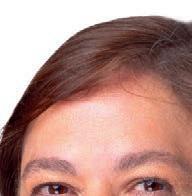



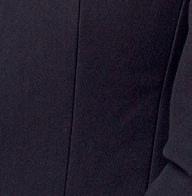








I hope more women feel encouraged to explore emerging elds like this where legal skills can align with meaningful change. Sometimes, the most rewarding careers begin not with a plan, but with an unexpected opportunity.


more sustainable
Tessa Brewis
MENTORSHIP AND COLLECTIVE UPLIFTMENT
KUDA CHIMEDZA , director – Banking, Finance & Projects at Cliffe Dekker Hofmeyr, shares real stories from mentorship relationships that have changed the trajectory of careers and lives
The year 2023 marked 100 years of women meaningfully participating in the legal sector. Yet, two years later, I still nd myself in meetings where I am the only woman (of
colour) present. There is still work to be done in opening doors for women. That said, I’ve been fortunate to build a career that illustrates how mentorship can be a powerful ladder for women to enter, engage and rise in law.
My introduction to mentorship was through my faith. At rst, my quiet demeanour and, if I’m being honest, lack of con dence (at the time), led to months passing without me approaching prospective mentors. I had not settled on a career, or anything really, until a church member offered to mentor me. She encouraged me to create a structured action plan for the next few years and this forced me to re ect and strategise. Dividing my life into categories, and speci cally planning for each of them, was the rst step to the career I now enjoy. She was brilliant and remained my mentor until her passing. Since she wasn’t a lawyer herself, there was a gap from a career perspective. So, I ended up having more than one mentor. Over the years, this has offered relief to mentors who generously offered their help, but didn’t have the capacity to be my “be-all-and-end-all”.
I’VE BEEN FORTUNATE TO BUILD A CAREER THAT ILLUSTRATES HOW MENTORSHIP CAN BE A POWERFUL LADDER FOR WOMEN TO ENTER, ENGAGE AND RISE IN LAW.
As the rst person in my family to pursue law, I was navigating unfamiliar territory. I met my second mentor through a law school mentorship programme. She taught me the prerequisites for a career in law: identifying strengths and weaknesses, dealing with imposter syndrome and other matters that would have been stumbling blocks in my career. Her guidance helped me to navigate law school and secure articles at one of the top rms in the country. She continues to provide great support as I grow in my career.
ALL TYPES OF MENTORS
As a candidate attorney, I was allocated to a director who became a technical skills mentor. She walked me through key sections of legislation, line by line, ensuring that I truly understood our work. She sparked an interest so deep that I eventually completed my master’s degree with research on a question I had asked during one of our training sessions. She was one of many colleagues who invested in ensuring I had the technical training required to excel. I have also been informally mentored by other colleagues who modelled what a successful legal career can look like for a woman of colour. My rm’s former chairperson is a great example. She demonstrated how to conduct oneself in a corporate environment, including dressing appropriately for a legal career. Although I did not work directly with her, she regularly checked on my upskilling and reminded me to pursue work-life balance. Although there was no structured mentorship relationship, I learnt volumes from observing and chatting with her.
Informal mentors have also been impactful advocates who have changed the course of my career. There were no
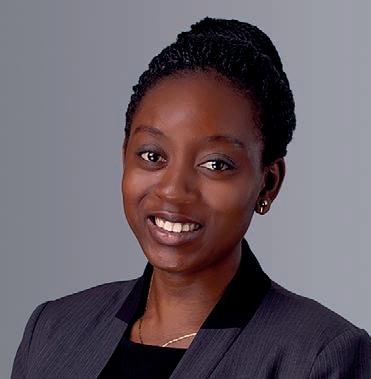
regular meetings to discuss career steps, but they became my sponsors in rooms I wasn’t in. Hard work and ambition could only take me so far. What moved the needle at key milestones was having people who advocated for me in my absence.
Mentorship has also come from unexpected sources. For example, a client who was a senior partner at another rm, now in-house counsel, provided me with invaluable advice on, among other things, business development. At this stage of my career, this guidance could not have been better timed.
I’ve been privileged to have many people invest in my growth. My career is evidence of the contributions of the women who brought me along as they rose and the men who choose to be allies in the upliftment of women in law.


Kuda Chimedza
THE PEARL THAT BROKE ITS SHELL
In December 2014, a 19-year-old law student, experiencing Sandton for the rst time, carried the hope of a future that was in the hands of an interviewer at one of the big ve law rms.
What did not occur to me at that time was that more than my hand-me-down suit, I remained clothed in the circumstances I had temporarily left behind, which would inform my performance in this new world. I was uncertain, timid and lacking in con dence. My background was rearing its head in a different environment. From that day and many days thereafter, the anthem –she needs to break out of her shell – rang.
In her book, The Pearl that Broke Its Shell, Nadia Hashimi explores the ancient Afghan tradition of bacha posh, where a girl lives and behaves as a boy to enable her to behave more freely and effectively provide for her family. Essentially, the girl assumes a different shell to t into a particular environment and achieve a particular objective.













My shell consisted of numerous layers. I was signed to a large law rm at age 19 and set to commence articles at age 21. With age comes experience, of which I had none. Coupled with youth was a sense of naivety exacerbated by the unfamiliarity of the turf. I was the very de nition of “wet behind the ears”, in boardrooms over owing with grey hair, eloquence, wisdom and experience. I was enveloped in insecurity. Moreover, I was draped in femininity; adorned in melanin. The legal eld is historically a white-male-dominated industry. Granted, great strides have been taken towards transformation. However, it takes concerted effort to nd your place at





Embracing her youth, identity and circumstances,
Cliffe Dekker Hofymer’s
NOMLAYO MABHENA-MLILO , director – Dispute Resolution, claims her place at the table
the proverbial table and reconcile the mind with the fact that you have earned it. Many call it imposter syndrome. I had spent four years at the University of Pretoria, being grilled in preparation in the letter of the law, but nothing could have prepared me for the cognitive dissonance that would engulf me in the corporate world.
ADAPTING, ADOPTING AND GAINING CONFIDENCE
What I had to grapple with, was whether to assume my version of bacha posh to assimilate into this new environment or embrace my circumstances, which I naively thought would be of no consequence. The answer was clear: to break out of my shell, I not only had to embrace it, but also harness it. I had to create and take up space at the table.
















I made the crucial decision to use the formative years of my career, as a candidate attorney and an associate, to learn as much as I could from my principals. I adopted a teachable spirit and honed my technical legal skills to ensure I provide sound and practical legal advice to clients. I became keenly aware that cultivating my technical abilities in the banking and property litigation, insolvency, liquidation and restructuring, and public law sectors, allowed me to approach the work with a sense of con dence. I learnt how to interact with clients in a professional and self-assured manner.



knowledge, at age 23, I sat for the conveyancing exam and became the youngest black female to be admitted as a conveyancer in South Africa. This opened new avenues leading to a seat at the table. The beauty of youth is that I had a roadmap of those who had walked the path before me. I allowed my shell to absorb the experiences and knowledge of my forerunners. With growth, came con dence, and with con dence, security in self. Within ve years, I went from associate to senior associate and then director at the age of 28. This was not a consequence of losing my identity, but rather, embracing it and infusing it with the tools afforded to me, which reminded me that I earned that seat at the table.





In pursuit of practical legal

SHOWING UP, AND DOING SO CONSISTENTLY
Drafting pleadings or giving an opinion to clients certainly comes easier than documenting one’s journey to and of leadership. What was particularly challenging in my journey and, I believe remains an obstacle for other women, is the absence of a blueprint to follow. As I pen this article, I hope to inspire hope, courage and audacity in those who are eager to take the baton. I share some of the principles that, I dare say, made success predictable. These were paired with systems I established to ensure I could produce and sustain the results.
First for me was branding. I have always been one to look for a differentiator. How do you show up before you even enter the room? What was my performance promise? I appreciated early in my career that I needed to build credibility through mastering my craft. Developing my talent and becoming great at what I do were important parts of my brand. Otherwise, my voice would not matter. In fact, I might never have even got a chance to be heard at all. It was important to know what I was doing and to be good at it. Linked to this is preparation. That is where I got con dence. I was ready, I knew the facts, I studied the law, identi ed loopholes and even foresaw sharp curves and U-turns.
Cliffe Dekker Hofmeyr’s PHETHENI NKUNA , director – Executive Management Office and director –Employment Law,
shares some of the secrets behind her success
development of female lawyers. Leadership goes beyond representivity. It is also about the corollary authority and having a voice. My sponsor threw me into the deep end –in matters, leading client engagements, and even championed by academic pursuits. He jokes about how he did not understand why a lawyer would want to do an MBA, but he supported me anyway. It was the gift of sponsorship, batting on my behalf. Getting my LLM and MBA were very much a part of the branding pursuit.
I BUILT A HABIT OF CONSISTENTLY DELIVERING EXCEPTIONAL OUTCOMES, IRRESPECTIVE OF THE CIRCUMSTANCES OR THE CLIENT.
THE UNFOLDING THEORY OF TURNOVER
In 2022, during our directors’ conference, I sat with another director and the CFO. During our lunch break, we chatted about associate attrition – the “Great Resignation” post-COVID-19. My MBA research had centred on the Theories of Motivation, looking speci cally at the Unfolding Theory of Turnover. Brie y, the Unfolding Theory highlights ve cognitive pathways (although more may exist) employees follow when deciding to leave an organisation. Understanding these pathways would propel the rm to put in place measures that would serve as shock absorbers and intentionally reduce the erosion of talent. It was this conversation that opened the door to the of ce I now occupy.
Beyond this point, my eyes are set on legacy. Ultimately, my goal is to have a professional presence that makes a difference. One of my passions is to mentor and sponsor, within and outside the rm, especially women, aiding other females in their professional development, building con dence and guiding them.








It took a lot of hard work, long hours and to complex and niche matters. I was fortunate to have worked with an incredible attorney did not “hold punches”. Sponsorships and making our male counterparts remain integral to closing the female leadership gap and advancing the career

Then showing up, and doing so consistently, even for the smallest opportunities. Through this, I built a habit of consistently delivering exceptional outcomes, irrespective of the circumstances or the client. As part of showing up, I re ned my language. Our bodies, circumstances, dreams and destinies pay attention to the words we speak intentionally or otherwise, there is no lter. It was important to speak well and reaf rm to my subconscious that I had what it takes, that I was capable and built for this. Added to this, was not ignoring the opportunity of networking – even with your colleagues.



It took a lot of hard work, hours and exposure to to have worked with an incredible who back the counterparts allies remain this. Added to this,





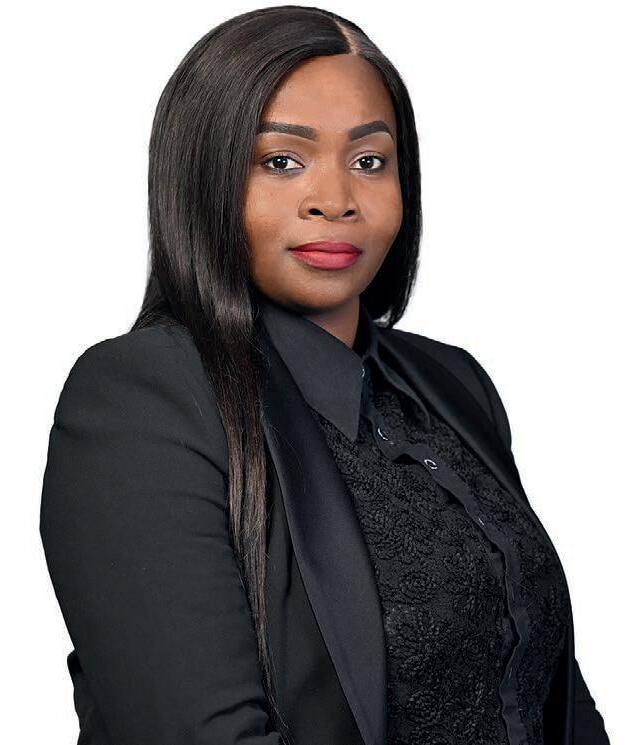


Phetheni Nkuna
THE FABLE OF THE FEE-BURNER
EMMA
HEWITT , practice management director – Corporate & Commercial at Cliffe Dekker Hofmeyr, writes about how the shared pursuit for excellence in the legal sector has shaped her career
Afable is a short ctional story that conveys a lesson. Its characters are often animals that are given human qualities. N’est ce pas? (isn’t it). This fable’s star character has to be my spirit animal – Miss Piggy from The Muppets!
My advancing BIG 50 birthday serves as a milestone for re ection. My journey through the legal profession has been shaped by opportunities to create and curate bespoke roles for myself and I am privileged to have been granted the space to do so.
I started out practising law, but I have been a fee-burner for much longer and Je l’adore (I love it)! I have the luxury of working in law, but I no longer have to account for every six minutes of my day. My current role is a mixed bag of duties and responsibilities. This chakalaka of strategy, operations, talent management, business development, marketing and knowledge management appeals to me as I get to do the business of law versus the practice of law. In doing the business of law, I enable my colleagues to excel in their practice of law and ultimately deliver rst-class service to our clients.
Admittedly it has taken resilience over the years to navigate the predominant divide in law rms between fee-earners, lawyers directly generating revenue, and fee-burners, those in support functions who do not directly contribute to the bottom line. This dichotomy has made support staff of all descriptions feel less important and valuable to our rms, even though we are crucial to the overall operation and delivery of services.
Fortunately, I see a shifting of perspective, with the profession no longer strictly con ned to these traditional paradigms, especially as legal practice
evolves and adapts to a “new world order” of doing law. Fee-burners are integral to the legal ecosystem and rightful recognition of this can be secured through deliberately demonstrating our value creation. While (we think) we do this as a matter of course, perhaps we don’t, or not quite as we should, translate the impact of our work into monetary terms. We know that universally money talks in any business and in all languages, l’argent est roi (money is king)! Strategic value accretion needs to underpin and drive our deliverables. I have not mastered this yet. It is a work in progress to know and show my worth in this way. For fee-earners, it is their lived reality, with their performance measured mostly by nancial contribution.
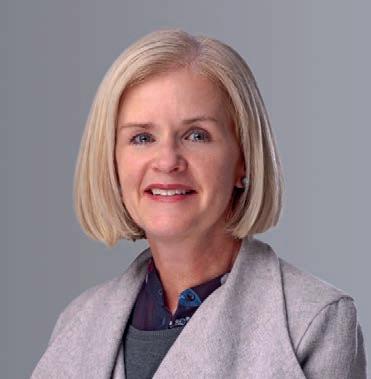
and fee-burning, a law rm cannot thrive. This is why I regard the talent-focused element of my job as paramount. Many lawyers, like a crème brûlée, may initially appear hardened, but once you break through the caramelised veneer, you discover layers of fabulosity, authenticity and sometimes even vulnerability. This realisation challenges the stereotypes surrounding the profession and invites a more nuanced understanding of the individuals within it. I invest much of my energy and time in this as I believe it supports and underscores the importance of inclusivity and community within the legal profession. Understanding and appreciating one another better creates improved opportunities for collaboration and connection resulting in better performance and service to clients. It is only through collective effort that true progress can be achieved. As Miss Piggy would put it in her best French accent, law is about moi et toi (me and you) in the shared pursuit of excellence.

iNCLUSIVITY AND COMMUNITY
While demonstrable value accretion is an imperative I need to elevate in my priorities, it cannot exclusively replace or relegate other fundamental rst principles of how I work. My professional journey has also been shaped by impactful collaboration with wonderful colleagues, from all levels and corners of the organisations where I have worked. Without talent, both fee-earning

Emma Hewitt
PURPOSE WITH POWER
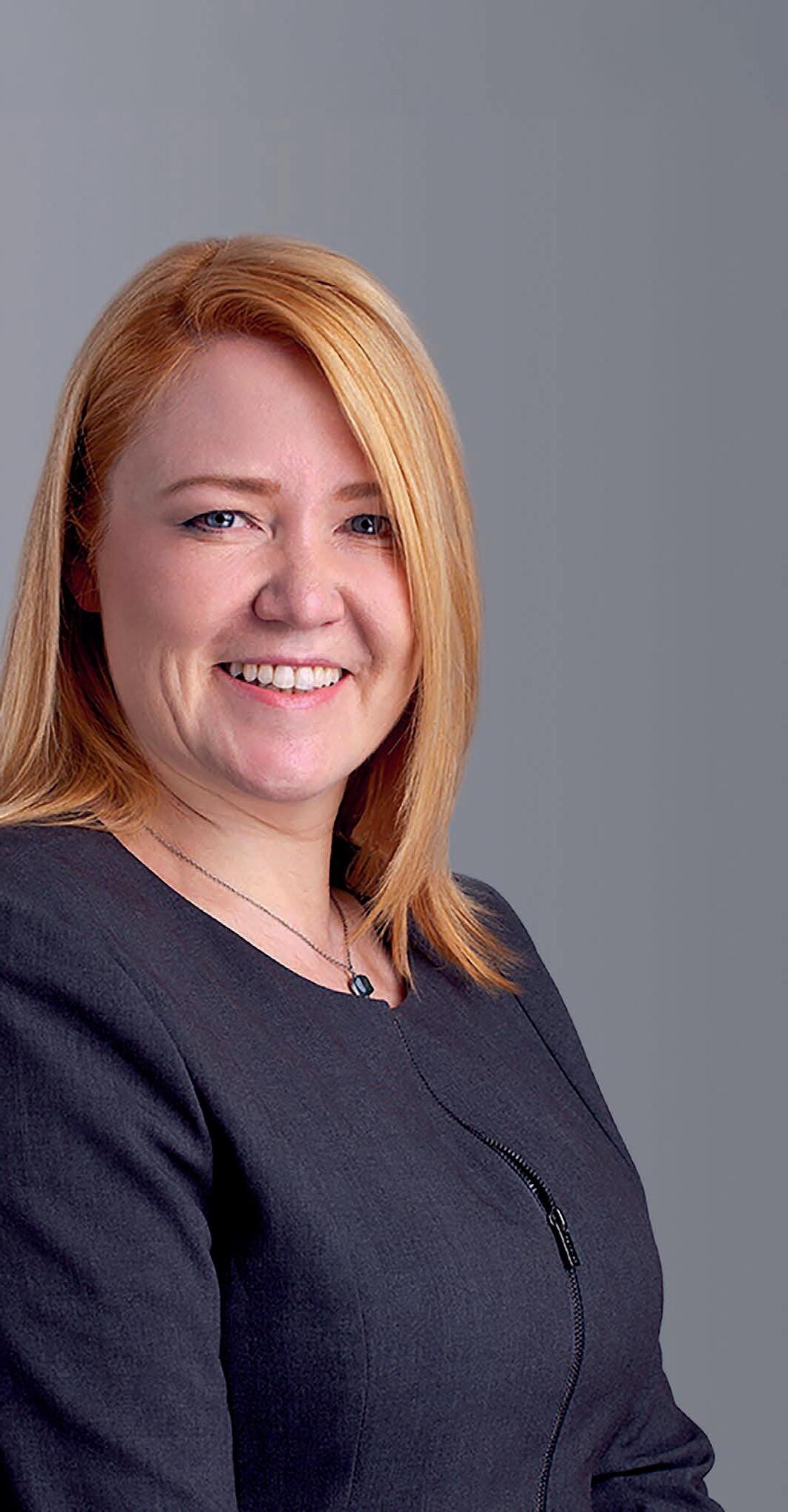
Retha Beerman
Empowering change in South African legal practice: the story of SA LawLabz, HiveLaw and the transformative role of female leadership.
By RETHA BEERMAN , managing director of SA LawLabz
As the world accelerates into the fourth industrial revolution, the legal profession is challenged to modernise – bridging the gap between traditional legal practice and the demands of modern practice. This includes the smart use of technology, while simultaneously removing barriers to entry to the legal profession based on gender, race or other arbitrary grounds and ensuring access to justice is not the preserve of a privileged few.
It is within this context that SA LawLabz (LawLabz) was conceived – a venture born not only of commercial ambition, but also
THE MAJORITY OF THE KEY ROLE PLAYERS (BUT BY NO MEANS ALL) WHO HAVE BEEN INSTRUMENTAL IN DRIVING THIS INITIATIVE FORWARD ARE WOMEN.
of a deep, shared commitment to social impact, equity and the empowerment of future generations of legal professionals.
The genesis of this ambitious plan was a coffee at Cliffe Dekker Hofmeyr’s (CDH) Cape Town of ces. Perhaps inspired by the grand view, a formidable team of academics (from the Nelson Mandela University), practising lawyers and legal technicians decided to put our collective heads together and come up with a platform that allows joint, multidisciplinary study of advanced legal technologies.
The result was LawLabz – a tech start-up with a dual mission: to deliver commercially viable products and services to the legal industry and enhance fair and equitable access to quality legal education and excellent legal services.
Our journey continued with a simple, yet profound question: How can we ensure that the next generation of legal professionals is equipped not only with legal knowledge, but also the digital skills and practical experience required to thrive in a rapidly changing world? How can we, as a collective, use technology to break down barriers to justice and empower communities that have historically been underserved?
We believed the answer lay in the modernisation of university law clinics –a critical training ground for future lawyers and a vital access point for community legal services. By transforming the way these clinics operate, we could simultaneously improve legal education, enhance access to justice and create a scalable model for broader legal practice reform.
THE
GENESIS OF HIVELAW: TECHNOLOGY AS A BRIDGE, NOT A BARRIER HiveLaw became the practical embodiment of our mission. Built on a SharePoint environment, HiveLaw is a legal practice management platform tailored to the unique needs of university law clinics and small law rms. Its design was informed by extensive collaboration with the Nelson Mandela University Law Clinic, which served as our pilot site and a living laboratory for innovation.
Our objectives were fourfold: (1) enhancing service delivery to the clients of law clinics; (2) modernising legal education by providing students with hands-on experience in the “digital discipline” of modern legal practice; (3)establishing a platform that allows advanced and multidisciplinary study of advanced technologies to enable academic guidance to the legal industry or its use and regulation; and (4) creating a scalable model by developing a solution that could serve as a prototype for other university law clinics, small law rms and nongovernmental organisations, enabling them to access competitive practice management tools and compete more effectively.
IT IS A TESTAMENT TO WHAT CAN BE ACHIEVED WHEN DIVERSE TALENTS AND PERSPECTIVES ARE BROUGHT TOGETHER IN PURSUIT OF A COMMON GOAL.
And so HiveLaw was born. It streamlines the full life cycle of legal matters, from client onboarding and document management to work ow automation and compliance. It is not just a tool for ef ciency; it is a platform for learning, designed to integrate teaching components and provide students with practical skills that are directly transferable to the workplace.
COLLABORATION AT THE CORE: THE POWER OF PARTNERSHIP
The creation of SA LawLabz and HiveLaw was made possible by a unique coalition of partners, each bringing distinct expertise and a shared commitment to social impact. CDH, one of South Africa’s largest and most respected law rms, provided deep legal and technological insight. CloudEssentials, our technology partner, brought the technical know-how to develop a simple yet powerful cloud-based system, ensuring accessibility even in remote locations. Without the vision, generosity and passion of these founding contributors, we would never have been able to achieve as much as we have done.
Yet, something that might not be immediately evident is the fact that the majority of the key role players (but by no means all) who have been instrumental in driving this initiative forward are women. In a world still dominated by a male presence, it is truly something to be proud of – the extent to which the initiative was the brainchild of and is being driven forward by strong female leadership. Quite organically, it has become a women-led team, but with extraordinary support and encouragement from all our male colleagues. This is a team that truly embodies a workplace that has transcended gender – even more remarkable given that it is a highly technical space.
The role of our female colleagues –everyone from the Nelson Mandela University team and consultants StrategicPulse Consulting and MatterCues to the LawLabz managing director (I have the incredible honour of being in that role) – have a majority, if not exclusively, female team.
The impact of these female participants has been felt at every stage of the initiative and has helped position LawLabz as a model for inclusive, socially responsible business in the legal sector.
Moreover, the presence of strong female leadership has fostered a culture of collaboration, empathy and empowerment within LawLabz. In doing so, it challenges traditional notions of hierarchy, proving that there is no reason at all for gender disparities to persist.
A CALL TO ACTION
The story of SA LawLabz and HiveLaw is, at its core, a story of partnership, purpose and the transformative power of inclusive leadership. It is a testament to what can be achieved when diverse talents and perspectives are brought together in pursuit of a common goal.
As we look to the future, I am proud to stand alongside our female partners and all those who have contributed to this journey. Together, we are not only modernising legal practice and education; we are building a more just, equitable and empowered society.
Let us continue to challenge the status quo, embrace innovation and ensure that the legal profession remains a force for good in South Africa and beyond.


LEGAL REFORMS EMPOWERING WOMEN
Cliffe Dekker Hofmeyr’s ANLI BEZUIDENHOUT , director – Employment Law, and NADEEM MAHOMED , director – Employment Law, discuss
how enhanced harassment protections and evolving parental leave will reshape the workplace
The contemporary employment landscape has witnessed signi cant legal reforms that have fundamentally enhanced women’s rights and protections in the workplace over the past 25 years. These developments, while bene tting all employees irrespective of gender, hold particular signi cance for women who continue to navigate complex workplace dynamics and balance professional responsibilities with parental obligations. This article examines two transformative legal developments: the comprehensive expansion of workplace harassment protections and the evolving framework governing parental leave entitlements.
ENHANCED PROTECTION AGAINST WORKPLACE HARASSMENT: A COMPREHENSIVE APPROACH
The judicial recognition of workplace harassment has evolved considerably, with courts now acknowledging that hostile work environments often stem not from the abuse of tangible economic power, but rather from the perpetuation of perceived societal power imbalances between men and women in relation to harassment based on gender and sex. This nuanced understanding has informed signi cant legislative reforms designed to create more equitable workplace environments and recognising that sexual harassment and sexist conduct should be untenable in the workplace.
On 18 March 2022, the Department of Employment and Labour promulgated the Code of Good Practice on the Prevention and Elimination of Harassment in the Workplace (the code), which superseded all previous codes relating to sexual harassment issued under the Employment Equity Act 55 of 1998. This code represents an important moment in employment law for several reasons:
• Expanded scope of harassment protection
The code’s most signi cant advancement lies in its comprehensive approach to harassment prevention. Unlike its predecessors, which focused primarily on sexual harassment, the code now addresses all forms of workplace harassment. This expansive scope includes protection against social origin harassment, thereby recognising the multifaceted nature of workplace discrimination and the various forms it may manifest.
• Extended geographic and temporal application
The code’s protective framework extends beyond the traditional con nes of the workplace. Protection now applies to any situation in which an employee is working or which relates to their employment.
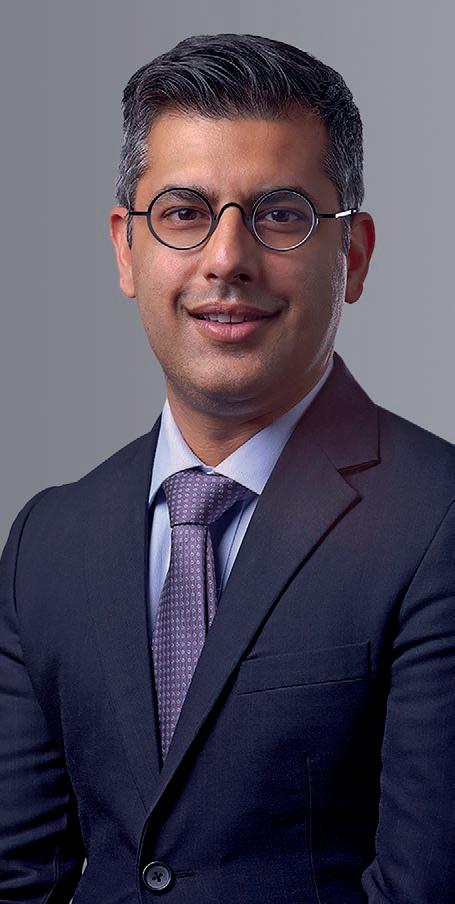
This includes locations where employees take rest or meal breaks, utilise sanitary, washing, changing, breastfeeding or medical facilities, and extends to workrelated trips, travel, training, events or social activities. Signi cantly, the code also encompasses commuting to and from work in transport provided or controlled by the employer, thereby acknowledging that harassment can occur in various work-related contexts.
• Comprehensive definition of sexual harassment
The code provides a detailed de nition of sexual harassment, encompassing verbal, physical, nonverbal and quid pro quo harassment. Speci c examples include unwelcome innuendoes, suggestions and hints, sex-related jokes or insults, unwelcome graphic comments about a person’s body made in their presence or directed towards them, enquiries about a person’s sex life and the unwelcome display of sexually explicit pictures and objects. These comprehensive developments serve to empower women by providing clear, expansive guidance on what constitutes inappropriate workplace conduct. Unlike previous frameworks, the current code’s detailed enumeration of prohibited behaviours removes ambiguity and provides all people, including women, with concrete grounds for asserting their rights to a safe, respectful and equal workplace environment.
PARENTAL LEAVE REFORM: ADVANCING GENDER EQUALITY AND FAMILY AUTONOMY
On 25 October 2023, the Gauteng High Court, delivered a groundbreaking judgement that fundamentally challenged traditional approaches to parental leave in the South African context. The court declared certain provisions of the Basic
Nadeem Mahomed
Conditions of Employment Act 75 of 1997 (BCEA) relating to maternity, parental, adoption and commissioning parental leave, as well as relevant provisions of the Unemployment Insurance Act 63 of 2001, to be unconstitutional and invalid.
The declaration was based on these provisions’ failure to align with the constitutional rights to equality and dignity enshrined in sections 9 and 10 of the Constitution of the Republic of South Africa, 1996.
The case arose from the application of a heterosexual couple. During the mother’s pregnancy, the father sought to access the four-month maternity leave bene t from his employer as the mother was self-employed and circumstances necessitated an early return to work. The employer’s refusal, based on a maternity leave policy that restricted bene ts to birthing mothers only, exposed the discriminatory nature of existing legislation and highlighted the urgent need for reform towards a gender-egalitarian approach to parental leave.
The court’s analysis focused on the broader concept of child nurture rather than merely the biological act of childbirth.
The judgement recognised that in respect of nurturing activities (excluding breastfeeding), any parent possesses the capacity to provide comprehensive care to their child. The court found the existing BCEA provisions fundamentally awed as they failed to recognise family dynamics where both parents are equally committed to child nurturing.
The court found no cogent justi cation for distinguishing between birthing and nonbirthing parents (including adoptive parents or those who have commissioned surrogacy arrangements) regarding the nurturing care newborn babies require for their safety and optimal development. The judgement emphasised that the assumption that birthing parents should invariably serve as primary caregivers fails to consider diverse parental arrangements and contradicts the constitutional principles of gender equality and human dignity.
The court described parenting as “sui generis and undoubtedly onerous, involving actual work, resilience in the face of exasperation, anxiety, unrelenting close attention to the newborn, extreme exhaustion, sacri ce of sleep and sacri ce of the pursuit of other interests”. The judgement recognised that fathers
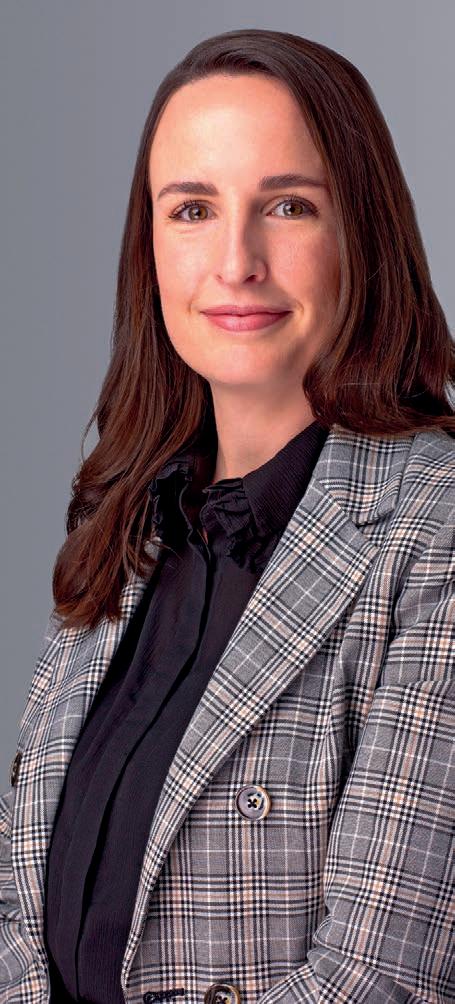
who choose to participate fully in this experience, for their own wellbeing and that of their children and partners, have legitimate grounds to challenge the unfair discrimination inherent in the BCEA’s unequal recognition.
Furthermore, the court acknowledged that mothers have an equally valid complaint against legislation that assigns them the role of primary caregiver who must “bear the rigours of parenthood single-handed”, emphasising that such arrangements should be matters of family choice rather than legislative prescription.
This judgement represents an extraordinary development towards equitable parental responsibilities. Should the Constitutional Court con rm this decision, female caregivers would be empowered to adopt family arrangements that best serve their speci c circumstances and preferences. This development would remove the legislative presumption that women must serve as primary caregivers and instead recognise family
autonomy in determining caregiving arrangements. However, until the Constitutional Court weighs in on the matter, the status quo remains.
BUILDING SAFER AND MORE INCLUSIVE WORKPLACES
Both legal developments examined in this article serve to empower women by contributing towards the creation of safer and more inclusive work environments. The comprehensive harassment protection framework provides women with clear, enforceable rights and expanded avenues for protection, while the evolving parental leave framework challenges traditional gender roles and promotes genuine equality in family responsibilities.
These reforms represent signi cant progress in dismantling systemic barriers that have historically disadvantaged women in the workplace. By providing legal protections against harassment and promoting gender-neutral approaches to parental responsibilities, these developments create a foundation for true workplace equality. The impact extends beyond individual rights, fostering cultural shifts towards more equitable and supportive work environments that bene t all employees while speci cally addressing the unique challenges faced by women in professional settings.
The trajectory of these legal developments suggests a continued evolution towards comprehensive gender equality in employment law, with implications that extend far beyond the workplace into the broader fabric of South African society.


Anli Bezuidenhout
BUILDING A BRAND WHILE BUILDING CONFIDENCE
LEILA MOOSA , senior associate – Employment Law at Cliffe Dekker Hofmeyr, reflects on her career journey, mentorship and leadership
Ivividly remember the early days of my legal career. Determined, capable (although it took years for me to believe that) and quietly aware of how few women occupied leadership roles in the of ces I walked past. As early as my rst “Big Law” interview when I was asked when I planned to have children, I was acutely aware that success in the legal eld did not just demand intellectual rigour; it demanded resilience. Especially for women and more so for women of colour.
I entered corporate law with little insight into “what to expect” beyond the select experiences of candidate attorneys at university career days. I knew there would be long hours. I knew performance expectations were high and regurgitating textbooks would offer little value to the team or the client. Fresh out of university, this was a major ask. It felt like there was simply so much law. That there was so much work to do even to be considered as adequate. How would I ever feel con dent that what I am producing is correct? What if it is wrong?
ONE OF THE MOST DEFINING ASPECTS OF MY CAREER HAS BEEN THE WOMEN WHO SAW SOMETHING IN ME BEFORE I FULLY SAW IT IN MYSELF.
Today, as a senior associate (having had one exit and return to the profession), I know that no practitioner knows everything. Some are close but they do
not know everything, even if they pretend to. Every practitioner must read, research, debate and consider the application to the matter at hand. There is no magic formula. There is no single answer. For me to understand this took time, a few detours, a lot of learning and, most importantly, the support of those who came before me.

THE POWER OF MENTORSHIP AND SPONSORSHIP
One of the most de ning aspects of my career has been the women who saw something in me before I fully saw it in myself. Their mentorship was beyond guidance or teaching me the technicalities of the law; it was about being given permission to dream bigger. It was about seeing a future where I could be a partner or director at a corporate law rm.
I distinctly remember the female partner who included me, a junior, in her matters when the work ow in my existing team had slowed down. There was no obligation for her to do this. I was not in her team. I was not her responsibility. There was no need for her to take time to train me, but she did. Now, I make it my mission to do the same. To take the extra step, in whatever form I can. Even if it is “less convenient”. Even if it makes me “less ef cient”.
Leadership today looks different from what we inherited. It is no longer about titles or tenure, but rather about impact. It demands leading with values, building workplaces that are psychologically safe and advocating for equity in boardrooms and beyond.
THE ADVICE I WISH I HAD BEEN GIVEN
To the young women entering the legal profession, you belong here.
There is no easy “way to the top”. It takes hard work. It takes perseverance, shifting gears and rethinking strategy at times. Spend time thinking about what drives you, what makes you unique. This is how you identify the value that you bring to your team and to clients, which, in turn, attracts like-minded colleagues and clients.
Know that those who have come before you (and me) have chipped away at barriers to allow us to break down the barriers in our paths.
When motivation is lacking and in despondent days, remember that your presence matters and your journey, career and success will not look like anyone else’s. It is not meant to.
Together, we are shaping more than the future of law. We are shaping a future world of work that is more inclusive, more rewarding and ultimately more sustainable for everyone.


Leila Moosa
